You have the power to thrive Resilience

OCTOBER 2019
EASE INTO SLEEP with Mindfulness Find the Courage to Live Your Truth THE GIFT OF LETTING GO 9 Practices to Make Friends with Change
◀ Jenée Johnson Program Innovation Leader On mindfulness, racial equity, and healing trauma with the San Francisco Department of Public Health

FEATURES

38
Changing the Narrative
Jenée Johnson shares how she is bringing mindfulness to the San Francisco Department of Public Health and encouraging conversations about race, trauma, and unconscious bias.

48 Lean In
Persevering in the face of adversity— and getting back up when you stumble—are essential to thriving in tough times, writes Linda Graham, MFT. No matter where you start, you can train your brain to build resilience.
54
Let It Be
If there’s one thing life teaches us, it’s that nothing stays the same. Yet we find all sorts of ways to resist, deny, and avoid this reality. Editor-in-Chief Barry Boyce offers nine perspectives to help us make friends with change.
62
Breath of Life
Think you know how to breathe? Some experts say 9 in 10 of us are missing out on the mental and physical benefits of breathing well.
On our cover: Jenée Johnson, Program Innovation Leader—Mindfulness, Trauma, and Racial Equity. Trauma Informed Systems Initiative. San Francisco Department of Public Health. Photograph by Stephanie Diani. Hair and makeup by Lindsay Eckardt. Wardrobe by Danielle Gaito.
PHOTOGRAPH BY STEPHANIE DIANI october 48 Resilience You have the power to thrive 22 Ease into Sleep with mindfulness 38 Find the Courage to Live Your Truth 54 The Gift of Letting Go 9 practices to make friends with change ON THE COVER Find Calm, Feel Renewed, and Make an Impact
Mindful’s 3rd annual online MEDITATION CHALLENGE mindful.org/m30
Join
38 October 2019 mindful 1




20 Mindful Eating A Taste of Intensity In the right proportion, horseradish can liven up a drink or a dip with its unmistakable nippy flavor. 22 Mindful Health Getting the Sleep You Need Strengthening your “mind muscle” might be the key to sound slumber at night. 28 How To Let Nature Heal You We know that trees are essential for the health of the planet. Turns out, they play a role in our health, too. 30 Inner Wisdom Life Is a Beautiful Buffet Every day, life presents us with a set of ingredients. It’s up to us to turn them into something delicious. 34 Brain Science Seeing the Truth of Inequality We all want to believe that we’ve earned what we have. True equality begins when we’re willing to see how the circumstances of our birth have helped us along. DEPARTMENTS 4 From the Editor 6 The Mindful Survey 10 Top of Mind 18 Mindful–Mindless 73 Bookmark This 80 Point of View By
october CONTENTS PHOTOGRAPHS BY STEPHANIE DIANI, DEEPOL BY PLAINPICTURE, AND MIKAEL OWUNNA. ILLUSTRATION BY CAROLE HENAFF. VOLUME SEVEN, NUMBER 4, Mindful (ISSN 2169-5733, USPS 010-500) is published bimonthly for $29.95 per year USA, $39.95 Canada & $49.95 (US) international, by The Foundation for a Mindful Society, 228 Park Ave S #91043, New York, NY 10003-1502 USA. Periodicals postage paid at New York, NY, and additional mailing offices. POSTMASTER: Send address changes to Mindful, PO Box 469018, Escondido, CA 92046. Canada Post Publication Mail Agreement #42704514. CANADIAN POSTMASTER: Send undeliverable copies to Mindful, 1660 Hollis St, Suite 205, Halifax, NS B3J 1V7 CANADA. Printed in U.S.A. © 2019 Foundation for a Mindful Society. All rights reserved.
Barry Boyce
“Whether we’re facing a series
of
small annoyances or an utter disaster, resilience is teachable, learnable, and recoverable. It takes practice and awareness, but that power always lies within us.”
62 44 54 38 Take a deep breath 2 mindful October 2019
LINDA GRAHAM

Dig Deeper
Mindful.org will be hosting a series of Q&As and guided meditations on resilience and healing racial injustice with Rhonda Magee, author of The Inner Work of Racial Justice.
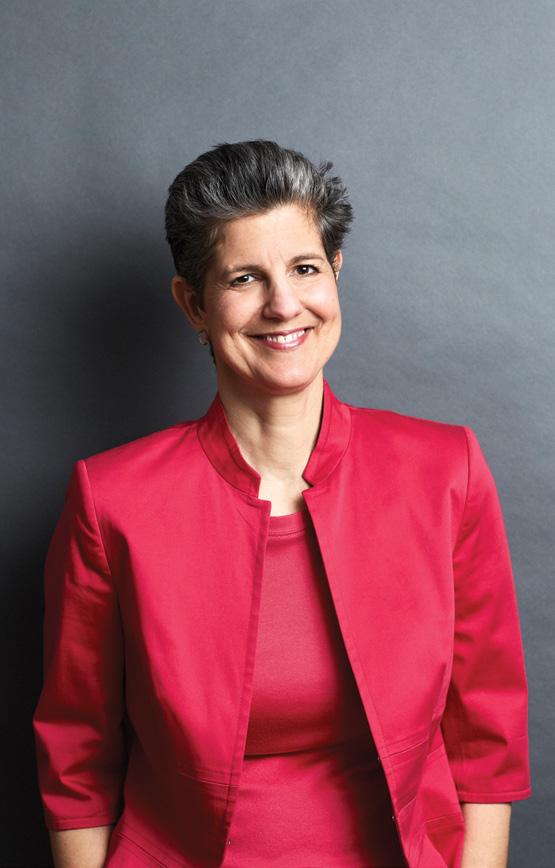
Sign up at mindful.org/Rhonda
Resilience.
I used to think it was a kind of toughening up, a leathering or weathering of our inner and outer resources that hardened our weaknesses and made us less vulnerable to the slings and arrows in life. Hemingway’s phrase about being “strong in all the broken places” seemed to poetically capture what I’d considered resilience.
But I don’t subscribe to that theory any longer.
No, I’ve come to see that resilience is the opposite. It requires mental suppleness, flexibility, and a raw vulnerability that allow us to dive deeply into our psyche—especially the broken places—and see ourselves, our thoughts and feelings, our beauty and longings, hurts and wounds, shadows, worst delusions and misdeeds, and to hold all of that with compassion, curiosity, and loving care.
And when we become more tender with ourselves, we can see a path to becoming more tender with others, too.
As we see our full humanity with loving eyes—all of it, the good, bad, and ugly—and learn to pause so we can bind up our own wounds, see our illusions, recognize our dreams, blow on the embers of our essence, and chart our own way forward, we can also see that fullness in others and recognize their triumphs, losses, delusions, misdeeds— and maybe even see their wounds that need binding and dreams that call out for nurturing.
When we understand resilience in that way, the world opens up to us. It reveals the strong places, and the broken ones, too. It calls us to pause and commit to our true human work. And that is the source of our thriving and our real power.
This issue, I hope you’ll join me in pausing and exploring some of the science and stories of resilience and vulnerability, especially the deeply affecting interview with cover person Jenée Johnson and her declaration of sovereignty and personal courage.
I hope you will find encouragement to lean into your mindfulness practice with clear, loving eyes. The slings and arrows of life are inevitable, but mindfulness can help us all to be magnificently resilient—and thrive— no matter what comes our way.
Love,
Anne Alexander is a longtime meditator, yogi, and editor. She is the author of two New York Times best sellers and has had a hand in shaping magazines, books, apps, and websites for Rodale, National Geographic, and more.
4 mindful October 2019
from the editor
PHOTOGRAPHS BY STEPHANIE DIANI
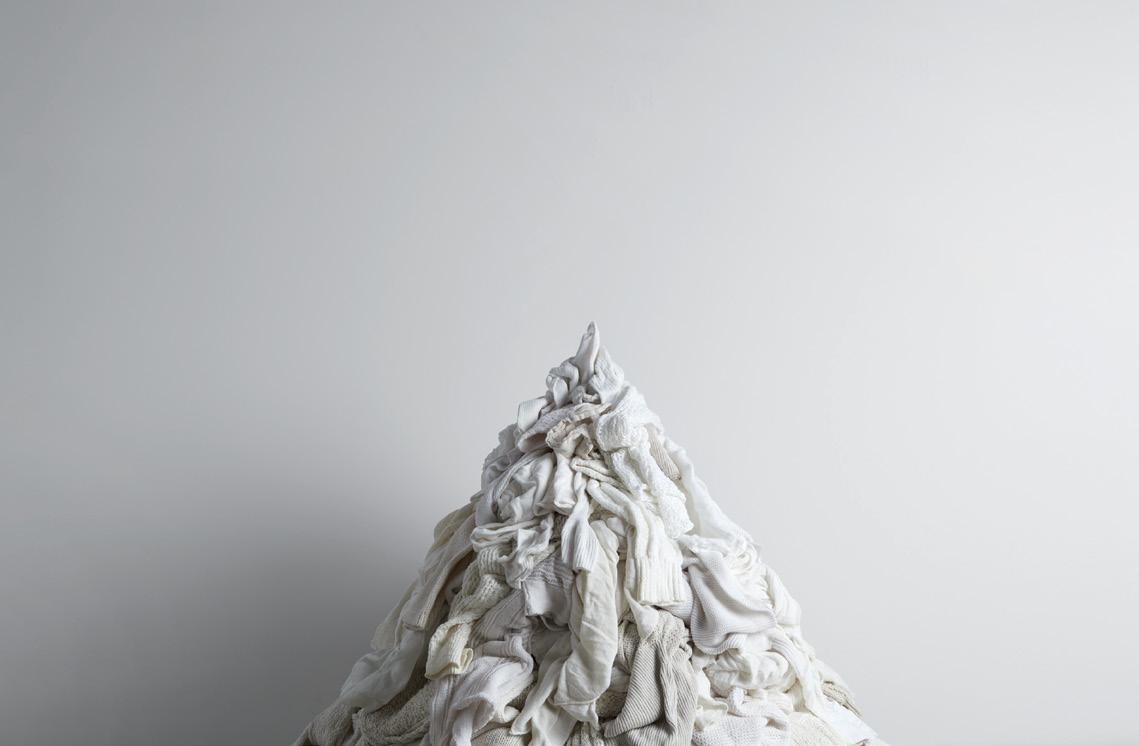

Holding Steady
When our inner resilience takes root, it allows us to empower ourselves, strengthen our communities, and lead more meaningful lives. Here’s what Mindful readers had to say about the role that resilience plays for them.
Who is the most resilient person you know and why?
MY HUSBAND. However dark the problem may be, he can see past it to the sunshine on the other side!
MY MOM—she took care of my dad with Alzheimer’s, as well as other residents of the nursing home. She carried on with grace and strength, even after she lost her love of 65 years.
MY DAUGHTER. I can’t believe how strong she is. No matter what life throws at her, she is able to look at it through clear eyes.
A FRIEND WHO IS 35 YEARS SOBER. She has the skills and she practices them!
definition
“My friend has been a Wellness Specialist at a middle school for over 32 years, and still shows up with caring and laughter every day. She always fights for the kids’ needs and radiates a smile, even with all that she’s been through in her life.”
ONE OF MY HIGH SCHOOL STUDENTS, who has had to face one adversity after another. Despite continual setbacks, he keeps on track to achieve his dreams.
What does resilience mean to you?
For some readers, being resilient means they can FIELD STRESSFUL SITUATIONS AND DIFFICULT EMOTIONS from day to day. For others, resilience comes up mostly in troubled times, enabling them to SURVIVE ADVERSITY OR TRAUMA . It can also include their readiness to ADAPT TO CHANGE and GROW STRONGER THROUGH LIFE’S CHALLENGES
Are you part of a resilient community?
Yes
68%
ME , from years of coping, and my strong sense of duty to my family.
MY SPOUSE. She puts up with me!
Resilience is the process of adapting well to adversity, trauma, tragedy, threats, or other sources of stress. It means “bouncing back” from difficult experiences. (Adapted from The Road to Resilience by the American Psychological Association)
Has mindfulness boosted your resilience?
71% Yes, definitely
4% Not really
32% No
19% I’m not sure
6% I don’t practice mindfulness
6 mindful October 2019 the mindful survey
Do you seek out people close to you to strengthen your resilience?
Over half (53%) of readers say they do have a healthy support network, while 39% say they tend to hide their struggles. And 8% say they aren’t sure how to reach out for assistance.
What are your key sources of resilience?
Life being the best teacher, 77% of readers say their resilience comes from their LIFE EXPERIENCE
SO FAR. The next predominant source of resilience is having a CONTEMPLATIVE OR SELFCARE PRACTICE (64%), followed by OPTIMISM AND POSITIVE SELFREGARD (52%)
PROGRAMS & TRAININGS
With The Mindfulness Center at Brown University
MAY 31-JUNE 2
HOW TO TAME OUR CRAVING MINDS
JUNE 2-9
MBSR IN MEDICINE, PRACTICE & SCIENCE
JULY 14-19
FRAMEWORK FOR LIVING
MINDFULLY: A 5-DAY MBSR INTENSIVE
For 47%, CLOSE RELATIONSHIPS also let them grow more resilient. 25% added WORKING ON IT THROUGH THERAPY helps.
Next Question…
How is mindfulness practiced in your community?
Send an email to yourwords@mindful.org and let us know your answer to this question. Your response could appear on these pages.
AUGUST 2-4
MINDFULNESS & TRAUMA CONFERENCE
AUGUST 18-23
THE PRACTICE OF RELATIONAL MINDFULNESS
OCTOBER 4-11
MBSR INSIGHT
MEDITATION RETREAT
OCTOBER 20-25
FRAMEWORK FOR LIVING
MINDFULLY: DEEPENING PRACTICE Rhinebeck,

39% 8% 53%
NY eOmega.org/Brown | 800.944.1001 October 2019 mindful 7
enjoyed by all.
Thank you!
Editor-in-Chief
Barry
Editor
Anne Alexander
Editor, Digital
Heather Hurlock
Production Editor
Stephanie Domet
Editorial Assistant
Amber Tucker
Contributing Editors
Sara Altshul
Teo Furtado
Katherine Griffin
Director of Operations
Julia Sable
Consumer Marketing Director






Leslie Duncan-Childs
Circulation Planning Director
Catherine Flynn
Circulation Promotions Director
Alan Brush
Administrative Assistant
Sarah Creelman
ADVERTISING INQUIRIES
Advertising Director
Chelsea Arsenault Toll Free: 888-203-8076 chelsea@mindful.org
Editorial & Central Business Office 5765 May Street, Halifax, Nova Scotia, B3K 1R6 Canada mindful@mindful.org
Editorial Inquiries
If you are interested in contributing to Mindful magazine, please go to mindful.org/submission-guidelines to learn how.






Chief Executive Officer
Bryan Welch
Creative Director
Jessica von Handorf
Senior Editor
Kelle Walsh
Associate Art Director Spencer Creelman
Senior Editor, Digital Nicole Bayes-Fleming
Editors-at-Large
Kaitlin Quistgaard
Hugh Delehanty
Director of Finance

Terry Rudderham
Accountant CPA, CMA
Paul Woolaver
Human Resources Manager
Cindy Littlefair
Graphic Designer
Christel LeBlanc
Customer Service
Subscriptions: Toll free: 1-855-492-1675 subscriptions@mindful.org
Retail inquiries: 732-946-0112
Moving? Notify us six weeks in advance. We cannot be responsible for issues the post office does not forward.
THE FOUNDATION FOR A MINDFUL SOCIETY
Mindful is published by the Foundation for a Mindful Society. The Foundation’s mission is to support mindfulness champions to increase health, well-being, kindness, and compassion in society.


Chief Executive Officer
Bryan Welch
Executive Director
James Gimian
Mindfulness in Education Program Manager
Chris McKenna
Please
donate
Did you know Mindful is a nonprofit? We are dedicated to inspiring and guiding anyone who wants to explore mindfulness to enjoy better health, more caring relationships, and a more compassionate society.
By reading Mindful and sharing it with others, you’re helping to bring mindfulness practices into the world where the benefits can be
make a donation to the foundation today by visiting mindful.org/donate
Welcome to mindful magazine • mindful.org Get More Mindful Print magazine & special topic publications 30 Day Mindfulness Challenge
Boyce
228 Park Avenue S #91043 New York, NY 10003-1502 USA Healthy Mind, Healthy Life Mindfulness video courses FREE! Guided meditations & podcasts Visit online at mindful.org 8 mindful October 2019
Authentic Leadership Program

Grow
• Easy-to-Use Online Learning Platform
• Two 5-Day In-Person Seminars
•
•
Sixteen Weeks Online and Two Five-Day Seminars in Boulder, CO
Sixteen Weeks Online and Two Seminars in Boulder, CO
Jan 13 - May 8, 2020
Onsites: Jan 27-31 and April 13-17
View full program information and apply at eNaropa.us/ALP2020
MINDFUL. CONNECTED. ENGAGED.
your
to
and to
new
in-depth
the World
capacity
face challenges courageously
realize
possibilities within yourself, your organizations, and society in this
experiential course. Explore the power of mindfulness and authentic communication for leading collaborative change. Become the Leader
Needs Now
Action-Learning Project
Personal Leadership Coaching
Top of Mind
SITTING IN THE MIDDLE OF IT ALL
Meditation flash mobs are upending the idealized quiet and calm practice setting, with public

group meditations.
“In public can be a richer place to practice,” says C. T. Tamura, founder of The Sitting Project, which hosts free sit sessions in Times
Square, NYC. “As meditators, we’re trying to open up to the world.” Many find that sitting silently amid hustle and bustle is one way to do that.
MINDFUL CITIES LAUNCHES
In May, Flint, Michigan, became the first city to adopt mindfulness programming to support the community. Civic leaders took part in Collective Wisdom, a two-day gathering featuring the Search Inside Yourself
institutions. Boston and Jackson Hole, Wyoming, will also join this pilot phase of the Mindful Cities Initiative.
MINDFUL AGING
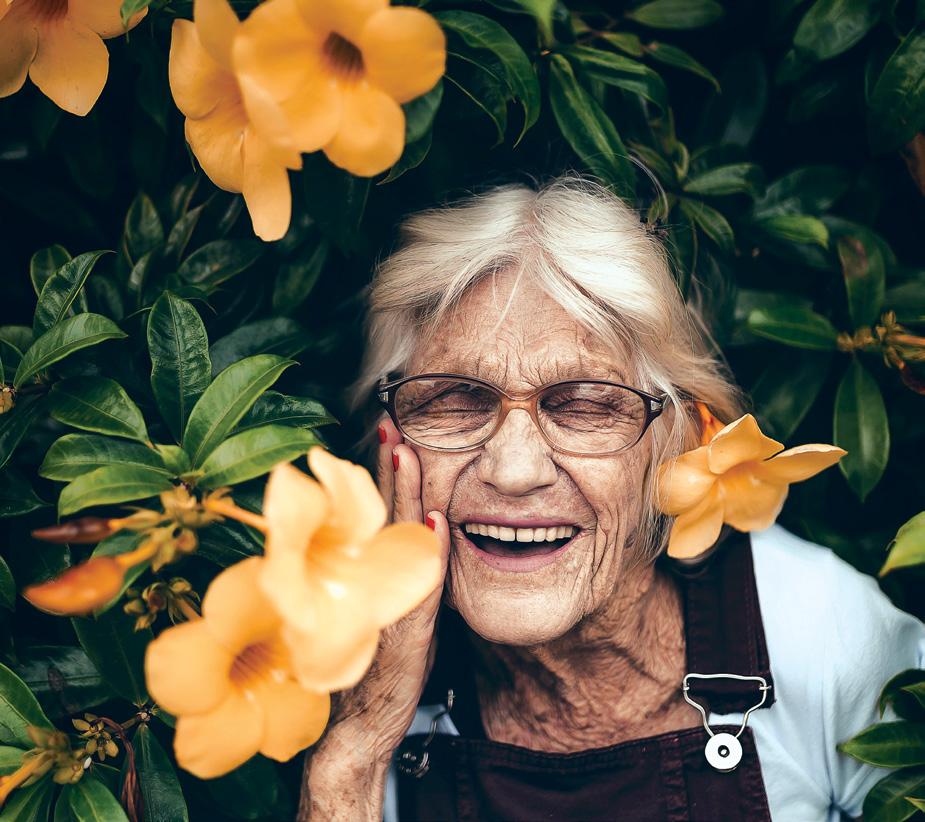
Leadership Institute mindfulnesstraining program, created at Google. Supported by the Foundation for a Mindful Society— the parent organization of Mindful—and The Crim Fitness Foundation, the initiative provides education and resources to city leaders and the public about the benefits of mindfulness meditation. It will also connect city leaders to experts, partners, and programs to offer mindfulness training in hospitals, schools, and other
How meditation can support healthy aging was the topic of the latest hearing held by Britain’s Mindfulness All-Party Parliamentary Group, featuring researchers and experts from more than 20 universities plus government and other officials. Presentations addressed concerns of aging including loneliness, anxiety and depression, managing illness, and supporting older people to continue to contribute.
Since forming in 2014, the BMAPPG has explored incorporating mindfulness into education, mental health, criminal justice, and more.
MINDFULNESS AS LIFE SKILL
“Adulting 101” courses are popping up at several North American high schools. These give senioryear students a leg-up toward
Keep up with the latest in the world of mindfulness.
PHOTOGRAPHS BY EDU CARVALHO, BTN
living on their own, teaching skills such as sewing on buttons, balancing a budget, and changing a tire. Teachers at E. J. Lajeunesse school in Windsor, Ontario, upped the ante with another excellent category: mindfulness and stress management.
MEETING A NEED
There was nothing like Liberate, a new free meditation app for Black, Indigenous, and People of Color (BIPOC), when Julio Rivera went looking. He came

mindful FAQ
Q
My teenage son has ADHD. I think mindfulness would help him, but he just rolls his eyes when I suggest it. Is there anything I can say to convince him to try it?
to meditation on the verge of burnout from a career as a software engineer. The Afro-Latino man often found himself in mostly white meditation spaces. After discovering a people-of-color sangha (community) at the New York Insight Meditation Center, he finally felt at home. He also realized he could cultivate a similar experience for others. The app features BIPOC teachers and addresses the complexity of living mindfully for those in the BIPOC community.
NERVOUS ABOUT CHANGE?
Try to: Increase your acceptance of not knowing and not being in control. Be open to what happens.
MINDFUL YOUTH
Mindfulness and meditation, says Emily Brierly, first helped her with anxiety and panic when she was 13. In the wake of the deadly May 2017 bombing of Manchester Arena, then-15-year-old Brierly leaned into meditation. “Mindfulness allowed me to let go of the need to control the future,” she told the Mindfulness in Schools Project (MiSP) 2018 Conference. In 2019, MiSP named Brierly one of their Youth Ambassadors, opening a new door to share her skills and passion for mindfulness with her peers. MiSP is a UK charity that provides secular mindfulness education for young people.
AADHD is a medical condition of executive function, not attention specifically. Executive function includes cognitive skills related to organization, planning, and goal setting. It impacts more than routine distractibility; it’s a “life management” disorder.
Teen ADHD creates a challenging developmental conflict. Teens typically want more independence. Perhaps because they don’t want to feel “different,” they often avoid their own medical issues. And since executive function is integral to judgment and planning, teens with ADHD are behind in their capacity to manage life independently.
For parents, family mindfulness begins with living it ourselves. From that start, make it real: Think like a teen. Take advantage of his desire for independence and reflect on his experience as it happens. Worried about a test? Can’t sleep? I’ve found mindfulness helpful. Teens also rely greatly on peers, which is why some mindfulness teachers see group programs as easiest for getting adolescents to practice.
Behavioral therapy is a proven ADHD support, so a psychologist familiar with mindfulness can also be a great step. In the end, since we can’t make anyone else practice mindfulness, sometimes it still comes down to patiently planting seeds for the future while remaining confident that our own practice influences our family for the better.
Mark Bertin, MD is a developmental behavioral pediatrician and an assistant professor of pediatrics at New York Medical College. His latest book is How Children Thrive: The Practical Science of Raising Independent, Resilient, and Happy Kids

October 2019 mindful 11
PHOTOGRAPH BY ALEX “NEMO” HANSE, STEPHANIE DIANI
ACTS OF kindness
Staff at Gwinnett County Animal Shelter in Georgia helped an evicted man and his dog. Katie Corbett was moved by the plight of Mr. Williams, a disabled veteran. Corbett found a foster for the dog, Lucky, and started a GoFundMe that raised more than twice its goal of $5,000. The money will help man and dog get back on their feet.
Three teens in southern Ontario ended a night of swimming with a more vigorous workout. Finding a car emitting smoke on a quiet highway around 1 a.m. and a driver who couldn’t afford a tow, the teens pushed while the driver steered home, more than four miles away. “We were raised to help no matter what,” Billy Tarbett, 15, told the Canadian Broadcasting Corporation.
Frustrated by the lack of resources at the hospital near Cape Town where she worked in nursing for almost 30 years, Olivia Pharo quit, cashed in her pension, and opened a health clinic nearby. She intends Sister Pharo’s Clinic to be a low-cost, onestop service. “Helping is not only a privilege, but also an honor. This is where my heart and soul is,” she told South Africa’s News24.
CRAZE OR CRAZY DOG DAYS
With hundreds of dogs at risk each year of vehicular heatstroke, car manufacturer Tesla presents: Dog Mode. The feature keeps the cabin cool even while the car is turned off, while the touchscreen displays the cabin temperature, along with a message that the dog is OK and the owner will soon be back. Pet welfare agency PETA points out technology often fails, and dogs are safest at home, with lots of water.
SCREEN TIME
Drivers may opt for “mindful mode,” in a new vehicle from Ford, which quiets the digital gaugescreen to show only the fuel level and speedometer. The company says: “Ford considers mindfulness necessary for its customers to help reduce their stress behind the wheel.” Stress that may be fed by the constant beeps of the pre-collision assist and lanekeeping options, not to mention the 10-inch touchscreen that channels your smartphone.

12 mindful October 2019
Yearning for a like-minded community and human connection that is accessible and convenient?


Challenged with creating a consistent meditation practice?



30-Minute group meditations on Mind Oasis offer next-level accountability, connection, and F-U-N! Unlike apps and recordings, Mind Oasis group meditation sessions are interactive featuring live friendly guides.

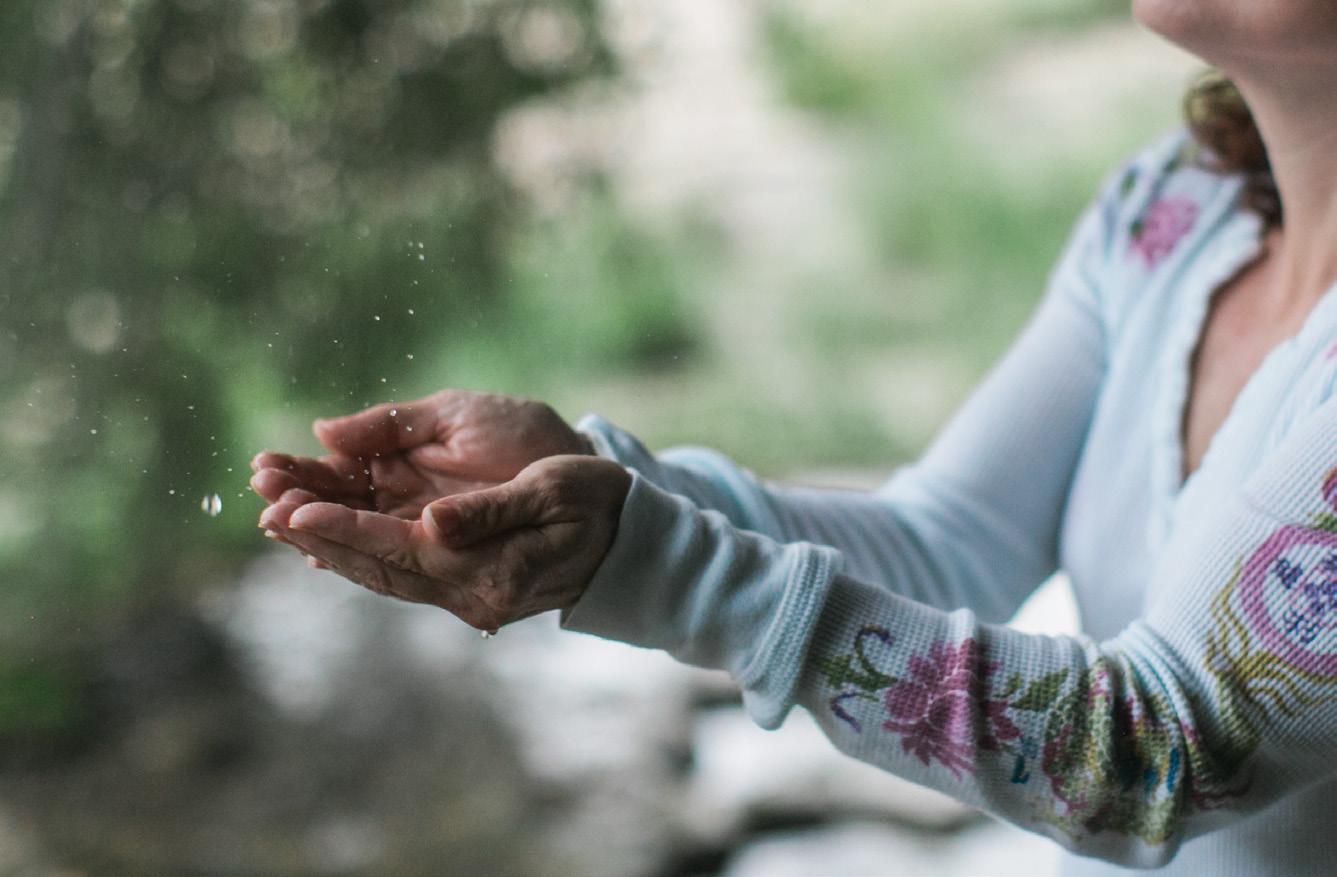
Come for the meditation. Stay for the community. Leave feeling energized! LIVE ONLINE GROUP MEDITATION START YOUR 3-WEEK TRIAL TODAY at MindOasis.org/Mindful
Photography: Lacey Melguizo, Unscripted Lens
Mindful Museum
Museums can be places of quiet contemplation, so it’s fitting that many now offer opportunities for mindfulness meditation. Here’s a sampling:
Museum of Modern Art in New York City offers Quiet Mornings at 7:30 a.m. on the first Wednesday of the month, to “take time to look slowly, clear your head, silence your phone, and get inspiration for the day and week ahead.” A guided meditation session follows.
LA’s Getty Museum hosts Ever Present, “an invitation to explore concepts of temporality and permanence through the work of musicians, artists, dancers, and other cultural vanguards.”
Manchester Art Gallery, England, hosts drop-in lunchtime mindfulness sessions to give “city-workers...important nourishment as well as respite from the noise and over-stimulation of the modern world.”
Institute of Contemporary Art at the University of Pennsylvania hosts
Mindfulness at the Museum drop-in sessions with instruction in meditation techniques led by local teachers “to help our wider community...have access to tools to become more aware” and so that participants may discover that this appreciation of the “here and now” extends outside the museum.
Weekly at Bainbridge Island Museum of Art , retired psychotherapist and Insight Meditation Teacher Steve Parsons offers a group mindfulness meditation practice.
Monthly, the Denver Art Museum hosts Mindful Looking for patrons to “discover overlooked details, explore ideas, and make connections as we linger, look, and discuss” select pieces of art.

Ashanti Branch
EVER FORWARD CLUB FOUNDER
Ashanti Branch was the man of the house at the age of seven. Growing up in Oakland, CA, the oldest child of a single mother, Branch never met his father, who died before Branch was born. He remembers navigating the rules at home—help out, be nice to your sister, be a man—and the rules on the street. “You can’t be too nice, you can’t be too kind, you can’t let people walk over you. That’ll get you beat up.” Branch learned to code-switch like a pro, “dancing between these different masks.” Taking on a parental role didn’t leave much time for being a kid. “I was often exhausted and frustrated: I don’t have no kids, why can’t I ever go outside and play?”
Branch sees himself in the young people he works with through the Ever Forward Club, a youth-mentoring and educator-training organization he started when he was teaching at San Lorenzo High School, California, and trying to figure out why his obviously bright students were failing his math classes. “A middle school teacher caught me and got me on the right track,” Branch says. But nobody had caught his high school students yet. Branch decided he would try. He had learned mindfulness meditation while on a Fulbright Scholarship in India, and mindfulness was one of the tools he offered his students.
His once-skeptical students began to anticipate weekly meditation sessions, where they gained tools for working with stress, anxiety, and anger, and taking off their “masks”— Branch’s way of describing the “too cool for school” persona many of us adopt. “They think they’re the only ones dealing with it. Everyone else is also wearing their masks, so there’s no safe place to take your mask off and recognize that you’re not alone.” Ever Forward became that for the young men he taught, and eventually for students of all genders across the country, including the 30,000 kids who have participated in the 100k Masks Challenge, drawing their masks on a postcard and writing three words that describe what they let people see, and three that describe what they don’t usually let people see. “Kids tell us amazing things about themselves,” says Branch, who now runs Ever Forward full time. “They want to talk about it. They want to be heard, they want to be seen.”
PEOPLE TO WATCH
14 mindful October 2019 top of mind
JOIN IN
Take Off Your Mask
Participate in the 100k Masks Challenge by downloading the postcard and following the instructions here:
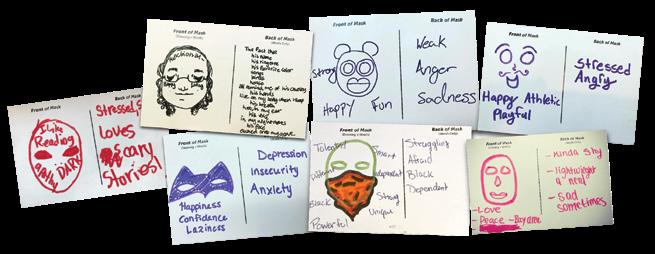
everforwardclub.org/ 100kmasks m
BEHIND THE MASKS
Some of the more than 30,000 postcards filled out as part of the Ever Forward 100k Masks Challenge. The front shows students’ public masks, the back reveals their inner selves. We asked Ashanti Branch how he would have filled out the postcard when he was a kid.
MIDDLE SCHOOL
“I didn’t trust many people in middle school, and since I was being bullied I really held back on the truth of my existence.”
Front
• Friendly
• Caring
• Nice
Back
• Being bullied
• Insecure, girls are not attracted to me
• Want to be liked
• Hate my home life
HIGH SCHOOL
“My intelligence was my ticket. I was super intense about my grades. I had to be careful not to let any craziness pull me down.”
Front
• Smart
• Friendly
• Dedicated
• Focused
• Hard working
Back
• Home life sucks
• I can’t wait to leave Oakland
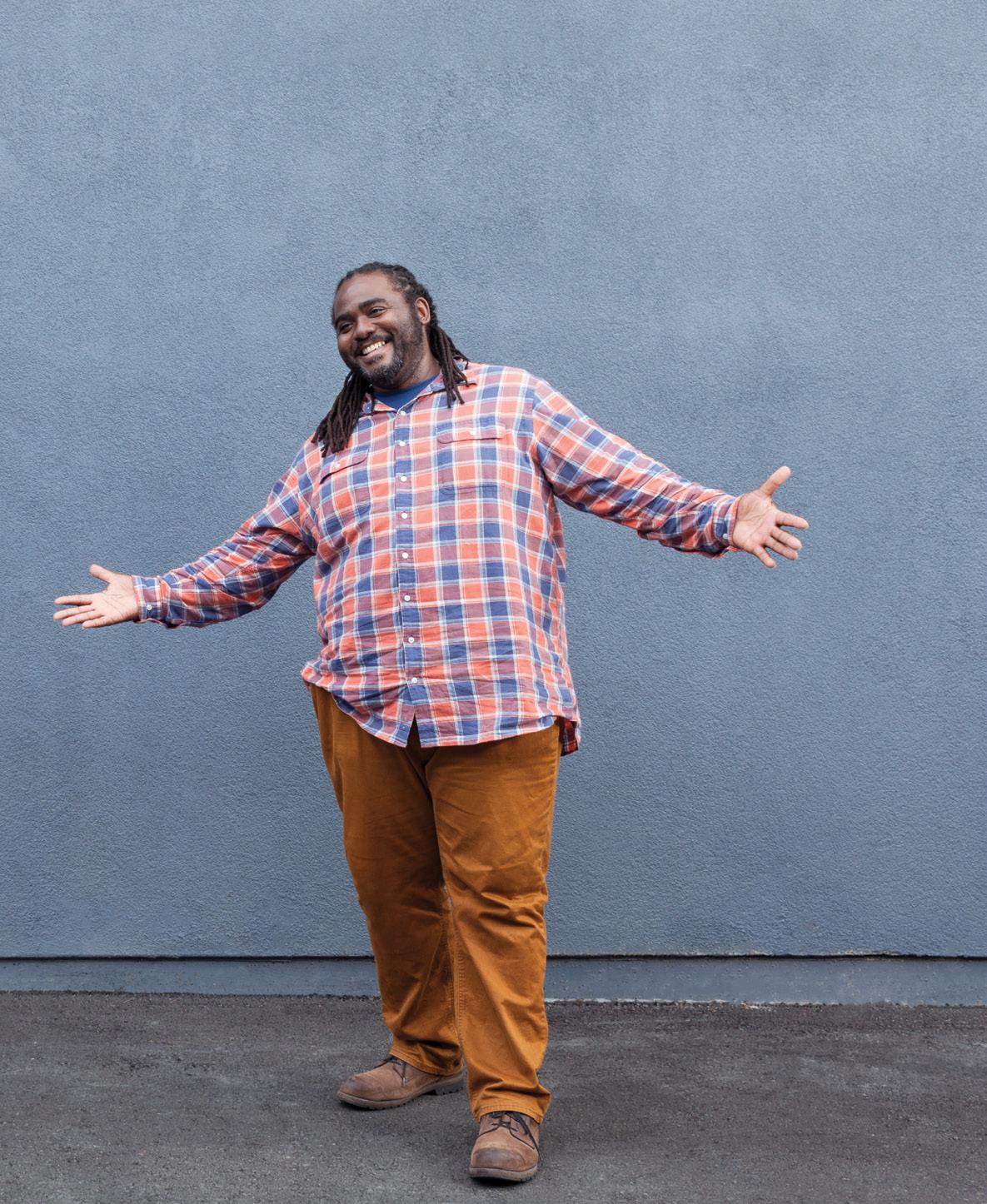
• Unhappy, unsatisfied
• Insecure about weight
October 2019 mindful 15 PHOTOGRAPH BY MCNAIR EVANS
Research News
by B. GRACE BULLOCK
group meditation retreat. On day four, each received either a dose of psilocybin, or a placebo (lactose).
functioning four months later compared to controls.
MIXING MEDITATION AND MAGIC MUSHROOMS
In a new study published in NeuroImage, scientists at the University of Zurich explore whether combining meditation with psilocybin—the chemical in magic mushrooms— may impact brain function and alter selfconsciousness even after the high is gone.
Thirty-eight experienced adult meditators were randomly assigned to either a psilocybin or placebo control group. They then participated in a five-day, silent
Before and after the retreat, members of both groups completed questionnaires about their experiences and perception and underwent an fMRI brain scan, during which they meditated. Four months later they filled out a survey about changes in their attitudes, moods, behavior, and social experiences.
After the retreat ended, mushroomassisted meditators reported less self-consciousness and more illusions and hallucinations than the control group. They also reported better social
Of course, neither meditation nor hallucinogen use is a one-sizefits-all proposition. The study authors caution that taking mindaltering drugs, for people who are either unprepared or with certain medical histories, may do more harm than good.
A LITTLE MEDITATION CAN GO A LONG WAY
Researchers at Western Washington University conducted a study to see if mindfulness meditation could enhance coping flexibility—the ability to pay attention to, and modify strategies for dealing with, stress. They recruited 115 students with no prior

16 mindful October 2019 top of mind
Research gathered from Australian Catholic University, University of Zurich, and Western Washington University
meditation practice and assigned half to a meditation group, and the other half to a waitlist. Then everyone completed a survey about their mindfulness, stress, and coping flexibility. Meditation group members received twoand-a-half hours of instruction, consisting of halfhour-long guided meditations and body scans, and were given a CD of the practices. They were asked to meditate at home for six days and record how often they practiced, and their mood and stress levels.
After six days, the meditation
non-meditation group, along with a significant boost in coping flexibility. Two weeks later, the meditators’ coping flexibility had increased further, but had dropped among the non-meditators.


the Institute for Learning Sciences and Teacher Education at Australian Catholic University, educators in 20 Australian schools volunteered to participate in a school-based study. Eighty-five teachers from 10 schools attended an eight-week mindfulnessbased program. Another 100 teachers from 10 different schools did not.
MINDFULNESS FOR EDUCATORS IMPROVES

WELL-BEING

Nearly 85% of school teachers say they’re facing burnout. Eight weeks of mindfulness-

group reported greater “dispositional mindfulness” (the ability to be nonjudgmentally aware of thoughts in the present moment) and less stress than those in the









based instruction may reduce stress, increase sleep, and promote health and well-being even weeks later, a new study finds.
Led by researchers at
After eight weeks, teachers who’d practiced mindfulness reported less stress, better sleep, and more mindfulness, self-compassion, and ability to use thoughts to help regulate emotions, compared to controls. There were no differences between the groups in teachers’ perceptions of their ability to engage students, provide effective instruction, or manage behavior in class, but students said they felt more connected to teachers who’d completed the program than those who hadn’t.
Students said they felt more connected to teachers who had completed the mindfulness program than those who hadn’t.
Meditation Cushions Inspirational Jewelry Home Furnishings dharmacrafts.com s i n c e 1 9 7 9 DharmaCraf ts MEDITATION SUPPLIES Call for Volume Pricing for Meditation Cushions 866.339.4198 Keycode MFA October 2019 mindful 17 top of mind
At Germany’s Circus Roncalli, it’s easier to care about creatures and enjoy the show. Roncalli phased out all live animal acts and uses cutting-edge technology to create a “performance” featuring dazzling holographic animals.
MINDFUL OR MINDLESS?
Our take on who’s paying attention and who’s not
by AMBER TUCKER
Jessica Anderson, a nurse in London, UK, beat the Guinness World Record for fastest woman to finish a marathon dressed as a nurse. But she was wearing scrubs, so Guinness, which still considers a nurse’s uniform to be a dress, says her record doesn’t count.
Climate change puts Africa’s baobab tree, a source of food, medicine, and shelter, at risk of extinction. To combat this, in northeastern South Africa a group of women called the Baobab Guardians nurture and monitor young baobabs for several years, then replant them in the wild.
For her role in the Broadway musical Oklahoma!, Ali Stroker made history as the first wheelchair user to win a Tony Award. But theater has a ways to go for inclusivity: The Tony venue’s stage had no wheelchair ramp.
Chris, a homeless man in Sydney, Australia, was distraught when his pet rat, Lucy, disappeared. A well-meaning passerby had thought Lucy was abandoned and brought her home. Thanks to a social media post, though, Lucy was soon returned to Chris.
A religious group in the US deplored Good Omens, a fantasy story, for depicting “devils and Satanists as normal,” and thousands of members petitioned Netflix to cancel it. This in itself was abnormal, as the miniseries is owned by Amazon Prime. ●
MINDFUL MINDLESS
18 mindful October 2019 top of mind




for anxiety & stress for better sleep for compassion for performance for children & families Introduction To Mindfulness: A Free 15-Day Course How To Teach Mindfulness with Confidence & Credibility Mindfulness Worksheets & Meditation Scripts Free mindfulness exercises, meditations & courses OVER 1,800 MindfulnessExercises.com
A Taste of Intensity
By Claire Ciel Zimmerman
Horseradish is spicy for a reason: The plant’s natural defense mechanism, when chewed, cut, or similarly disturbed, is to release chemical compounds that make your eyes and nose burn. The spiciness of horseradish comes from the chemical allyl isothiocyanate, which is also found in mustard and other radishes, and is closely related to the chemical that makes you cry when you chop an onion. While spicy chilies get their heat from capsaicin, which creates a burning sensation when it touches your tongue, allyl isothiocyanate is released as a vapor. The burn from horseradish is therefore as much about the sensation in your nasal passages as on your tongue. Too much horseradish can leave you hurting, but in the right proportion it can add a spark to savory dishes like roast beef and egg salad, or to a Bloody Mary. Often, horseradish is served as a condiment, grated and combined with an acid. It is also the feature ingredient in many European sauces, added to a creamy base like sour cream or mayonnaise. The cool, soothing creaminess and bright acid round out the pungency of the radish, allowing it to tantalize without overwhelming.

TRY THIS:
Mix one part lemon juice, two parts freshly grated horseradish, and three parts crème fraiche or sour cream Add salt and pepper to taste. Refrigerate, covered, for half an hour. Enjoy as a dip with veggies, spread on a cracker, dolloped over a baked potato. As you eat, notice how it feels on your tongue and in your nostrils. Does the sensation change over time? Where do you feel it first, and where does it linger? How does the warmth move through your body? ●
ABOUT THE AUTHOR
Claire Ciel Zimmerman is a former senior editor for Mindful
PHOTOGRAPH BY SERGEI CHAIKO / ALAMY STOCK PHOTO
20 mindful October 2019 mindful eating



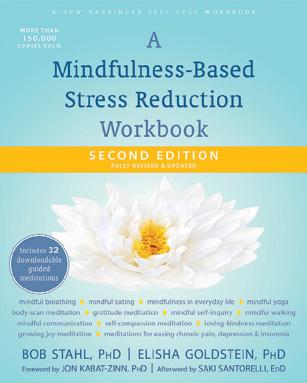

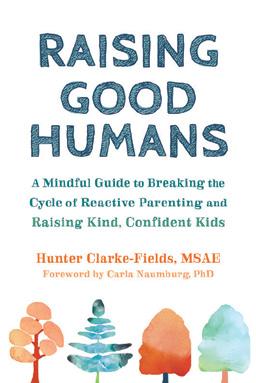
new harbinger publications new harbinger .com
Win a FREE book bundle today! Sign up at bit.ly/bbmindful to enter to win free copies of the featured books. Coming December 2019 For Teens ISBN: 978-1684032587 | $16.95 ISBN: 978-1684033317 | $16.95 ISBN: 978-1684033676 | $16.95 ISBN: 978-1684033492 | $16.95 ISBN: 978-1684033553 | $25.95 ISBN: 978-1684033881 | $16.95
Books to Inspire Lasting Change
Getting the Sleep You Need
Strengthening your "mind muscle" might be the key to sound slumber at night.
You can’t fall asleep, or maybe you drifted off a couple of hours ago, and now you’re wide awake, feeling lonely and a little desperate.
Lying in the dark, you start to panic: You know your alarm will go off in just a few hours and you’ve barely slept a

ABOUT THE AUTHOR
Sara Altshul is an award-winning journalist who has covered natural and alternative healing for over 20 years. Her articles have appeared in magazines including Prevention, AARP, Arthritis Today, and Health. She is the author of Kitchen Cabinet Cures
wink. You need to be alert and ready to tackle the day ahead, and you’re sure that without enough deep, restful sleep, you’ll barely be able to function.
Your worry is well-placed, says Matthew Walker, PhD, professor of neuroscience and psychology at the University of California, Berkeley, and director of the Center for Human Sleep Science. He has studied the many ways a lack of sleep affects you. For example, your attention span, mood, and memory suffer. Over time, he suggests, sleeplessness could also
lead to unwanted weight gain and negative mood problems. In up to 15% of adults, insomnia causes daytime distress or impairment, with the risk for insomnia being greater in women and older adults.
When it’s happening to you, there’s little consolation in knowing that inadequate sleep, or insomnia, is a problem shared by some 50% of all adults, according to the American Academy of Sleep Medicine. That means nearly half of us have trouble falling asleep and staying asleep, wake up too →
By Sara Altshul
22 mindful October 2019 mindful health

early, or wake feeling unrefreshed even when we’ve had plenty of time and opportunity to rest.
QUALITY OVER QUANTITY
What does a night of sleeping really well look like? According to the National Sleep Foundation, people who experience quality sleep spend at least 85% of their total time in bed asleep, are asleep within 30 minutes of going to bed, only wake once per night, and remain awake for less than 20 minutes before falling back to sleep.
The National Sleep Foundation notes that most adults from age 18 to 64 can aim for seven to nine hours of shut-eye each night, with adults over 64 needing slightly less. For teenagers age 14 to 17, getting eight to ten hours is recommended. However, the quality of sleep may be more important than the quantity, say experts. Deep, uninterrupted sleep is restorative to the whole body: It’s when our brains process what we’ve learned during the day, storing information and memories. Sleep also lowers your pulse and blood pressure, letting the heart and blood vessels rest. Our mental health, immunity, hormonal balance, and metabolism all rely on getting sufficient, high-quality sleep.

If you don’t meet those ideal sleep targets and tend to wake up underrested, mindfulness could help you.
“Mindfulness can quiet the brain and allows for deeper sleep,” says Shelby Harris, PhD, a clinical sleep psychologist in private practice in Westchester, NY. One of the biggest problems her clients share is dreading the night as it comes and growing anxious about trying to make themselves get sleepy. They worry, she says, that they “won’t be able to do X, Y, Z the next day” if they don’t sleep. “That thought process makes you stressed, worrying—often unnecessarily—about the next day’s effects. That cycle worsens sleep,” says Harris.
Mindfulness can set the stage for sleep by allowing you to be more
aware of your thoughts and to be able to let go of those anxieties instead of getting stuck on them, says Harris. “Strengthening your ‘mind muscle’ through daily practice helps you better recognize the negative insomnia-inducing thoughts and let them pass.”
MIND SOOTHER
Not only does it prepare your mind for drifting off to sleep, mindfulness meditation can also significantly improve sleep quality, says Heather L. Rusch, PhD candidate and research fellow at the National Institute of Nursing Research, National Institutes of Health. She reviewed 20 studies that evaluated the effect of mindfulness meditation on sleep quality and published her findings in
the Annals of the New York Academy of Sciences in 2018.
Mindfulness, Rusch learned, beat standard insomnia treatments, such as suggestions for improving sleep hygiene (eschewing TV and other screens before bedtime is a prime one). And the benefit continued “both immediately after treatment as well as 5 to 12 months later,” she says.
However, because mindfulness is a relatively new concept in insomnia research, we don’t yet know how long you need to practice before achieving better sleep. “We simply don’t have that information yet,” says Harris.
“What is key is that you practice mindfulness long enough to become aware of the thought processes you have that may get in the way of your sleeping,” says Harris. “Your daily routine practice can be short or long—it really varies! What’s important is the ability to be aware of your thoughts.” →
“STRENGTHENING YOUR ‘MIND MUSCLE’ THROUGH DAILY PRACTICE HELPS YOU BETTER RECOGNIZE THE NEGATIVE INSOMNIA-INDUCING THOUGHTS AND LET THEM PASS.”
SHELBY HARRIS, PHD, CLINICAL SLEEP PSYCHOLOGIST
24 mindful October 2019 mindful health

UNEXPECTED BENEFIT?
A surprising new finding about what happens in the brains of people who have chronic insomnia was revealed in a 2019 study by sleep expert Jason C. Ong, PhD, associate professor of neurology (Sleep Medicine), Northwestern Medicine, Feinberg School of Medicine.
Setting out to learn about the potential effects of mindfulness meditation on brain activity while people sleep, Ong discovered that after participating in an eight-week mindfulness course, people experienced an increase in brain activity that is usually linked to disturbed sleep. But the participants reported that their sleep during the study had improved.
“We are still trying to understand this paradoxical finding, but one interpretation is that mindfulness actually stimulates the brain during sleep without the anxiety or negative emotions that typically come with insomnia,” Ong tells Mindful. Mindfulness can boost sleep quality, Ong continues, because it helps you feel kindness
toward yourself and let go of habitual rumination—including the worry that your life will fall apart if you don’t get a prescribed amount of sleep.

DOS & DON’TS FOR QUALITY SLEEP
If disturbed sleep is becoming your new normal, you need a reliable way out. Preferably a natural one, like mindfulness, because sleeping pills can be “blunt instruments that do not produce naturalistic sleep,” says Walker.
Maintaining a regular, daytime mindfulness meditation practice will help you sleep better and longer at night. However, it's best not to think of it as a panacea if you wake up at 3 am. In this case, you might try a body scan while in bed, to relax any tension you may be holding in your body.
And if sleep still doesn’t arrive, you can do a mindfulness practice, but get out of bed and do it elsewhere. Staying awake in bed for longer than about 20 minutes creates an association that the bed is for other activities
as well as sleep, says Harris. The point isn’t to fall asleep in the midst of your practice, but afterward when you return to bed.
Another expert tip: Don’t rely on those ubiquitous sleep apps. “A lot of people use them as a sedative, but that’s not ideal,” says Harris. “You shouldn’t need to rely on anything to fall asleep—what happens if one day your phone is out of juice or the app doesn’t work?”
When you need help drifting off in the wee hours, don’t try to force it. As every insomnia sufferer knows, the more you lie there trying to make yourself sleep, the more it won’t happen. Notice your worries about being unable to sleep, your noisy mind, and visualize them floating by. The more you do this and accept that you cannot force sleep, the easier sleep will come.
Finally, don’t watch the clock. Trying to calculate how many hours you’ve been awake, or how many more hours you have left to sleep, only worsens insomnia, notes Harris. Set an alarm for your wake time and don’t look at it until it goes off in the morning. ●
Explore
MEDITATION A Body Scan to Help You Sleep
this research-backed guided meditation to calm your body and improve your quality of sleep. mindful.org/ sleep-meditation m
26 mindful October 2019 mindful health
Why Mindfulness Matters


In this FREE training, you’ll discover how mindfulness can:


• Bring you closer to your wholeness
• Unleash deeper creativity
• Allow you to be more resilient in uncertain times
About Your Teacher


Jon Kabat-Zinn, PhD, is a best-selling author and professor of medicine emeritus at the University of Massachusetts Medical School, where he cofounded the world-renowned Mindfulness-Based Stress Reduction (MBSR) Clinic and the university’s Center for Mindfulness in Medicine, Health Care, and Society.

KABAT-ZINN
presents a FREE training with JON
up for your training today!
Sign
mindful.org/JKZtraining
Let Nature Heal You

We know that trees are essential for the health of the planet. Turns out, they play a role in our health, too.
myriad other sources maintain that the simple act of intentional, attentive time with trees:
• Decreases fatigue
• Increases the ability to focus, even in children with ADHD
• Speeds up recovery from surgery or illness
• Regulates the endocrine (hormonal) system
Tap into a deeper sense of purpose and well-being with this VR forest meditation. mindful.org/ awewalk
We all know intuitively that going outside is good for us, and a growing foundation of science and neuroscience underlies the health benefits of being outdoors. In the 1980s, the secretary of Japan’s Ministry of Agriculture, Forestry, and Fisheries coined the term shinrin-yoku for making contact with and being affected—both physically and mentally—by the atmosphere of the forest. Shinrin-yoku translates in the West as “forest bathing” and is part of what I call the green cure: connecting with the natural world to help us thrive physically, cognitively, emotionally, and even spiritually.
Forest bathing incorporates many of the benefits of meditation while getting us outdoors and in motion. In a study at the College of Landscape Architecture at Sichuan Agricultural University, 30 men and 30 women were given a route of the same length to walk in either a bamboo forest or an urban area. The researchers measured blood pressure as well as electrical activity in the brain using an EEG, and they found that, among those who walked the forest path, blood pressure was lowered significantly as attention and concentration improved. The people walking in nature reported less anxiety and a generally happier mood than the urban group.
The New York State Department of Environmental Conservation and
• Enhances the ability to relax and get a better night’s sleep
• Increases energy Forest bathing is an active process, not just a matter of being near trees as static objects. Many species, including pine, yew, hop hornbeam, and sugi, emit biochemicals called phytoncides, pungent essential oils with antimicrobial properties that interact with our central nervous system and have calming, anesthetic qualities. They have been proven to boost the trees’ health as well as our own immune systems.
PARTING THOUGHT
Earthing involves walking barefoot and connecting directly to the soil without the barrier of pavement or shoes. It is a matter of contact with our soil, our planet— of truly touching Earth.
The science is still fairly new and limited on this subject, but studies have shown how the electrically conductive contact between human bodies and Earth’s surface seems to have an effect on health: It may diminish inflammation, enhance immunity and wound healing, and may also lessen pain by altering the numbers of circulating white blood cells (neutrophils and lymphocytes) affecting inflammation.
By Alice Peck
VIDEO An Awe Walk in the Woods
m
28 mindful October 2019 how to
Adapted with permission from The Green Cure: How shinrin-yoku, earthing, going outside, or simply opening a window can heal us, by Alice Peck, CICO Books, 2019.
ABOUT THE AUTHOR
You need only the most basic equipment: walking shoes and natural insect repellent. Leave your camera, your journal, and your guidebooks behind, and turn off your mobile devices. Forest bathing is about being, not analyzing.

1 Find some trees. This can be a forest of ancient pine or a copse of paper birch, or a single maple in your backyard. Of course, spending more time with more trees is better, because the effect is multiplied. Studies have shown that spending three days and two nights in a thickly wooded area will improve the function of the immune system for up to seven days—but do the best you can. A little forest bathing is better than none.
2 Find somewhere to sit or lean, where you can be still for 10-20 minutes or more without being in the way of bicycle traffic, ants, or poison ivy.
3 Now do just that—be still. Be aware of your breath, but don’t force it. Let the experience come to you, don’t analyze. See what you see, hear what you hear, smell what you smell, feel what you feel. Light through the leaves…skittering or birdsong…blossom or decay…calm or grounded…
4 As you walk home, check in with yourself. Do you notice any changes in your body? How about your state of mind? What can you take from your forest bathing experience back to your daily life? Do you feel more optimistic? More serene? How is that headache?
5 Repeat as often as possible. ●
October 2019 mindful 29
Alice Peck is drawn to finding the sacred and science in nature, healing, and everyday things. She is also author of Be More Tree, Mindful Beads, and The Secret Language of Herbs.
PHOTOGRAPH BY SEBASTIAN UNRAU / UNSPLASH
Life is a Beautiful Buffet
I love to cook. The kitchen was where, as a child, I first discovered that I could be a creator. As I explored and experimented with all kinds of dishes, I came to appreciate that it’s not just the ingredients, but how you work with them, that makes a meal wonderful.
That’s why, in addition to cooking, I love watching cooking shows. One of my favorites is MasterChef, with its “Mystery Box Challenge.” The Mystery Box might hold durian or dogfish,
THE AUTHOR
Spam or spaghetti. All contestants start with the same raw materials, but they don’t know what they’ll get until the box is opened. Each chef draws upon the richness of their culture, their culinary training, and their unique take on life to dazzle the judges and win hearts and stomachs. Everyone has the potential to face glory or mishap.
What a perfect metaphor for daily life. Each moment offers us a rich spread of ingredients and options. We might find some experiences more delectable or desirable than others, but it’s up to us to decide how we work with them, doing the best with what we have.
Today, for example, I noticed a feeling of joy as an early morning light came into the room. At the same time, I felt edgy about some tasks I needed to accomplish. So joy and edginess were two ingredients in my day. Noticing the ingredient of “enjoying the sunlight” allowed me to connect with simple happiness, while the ingredient of edginess was like making a dessert that featured jalapeños. I let myself feel how my body was responding to the prickly heat of edginess. As I investigated its characteristics, instead of seeing it as a problem I was able to enjoy watching my spicy edge keeping things perky. And because I brought awareness to this peppery friend, I →
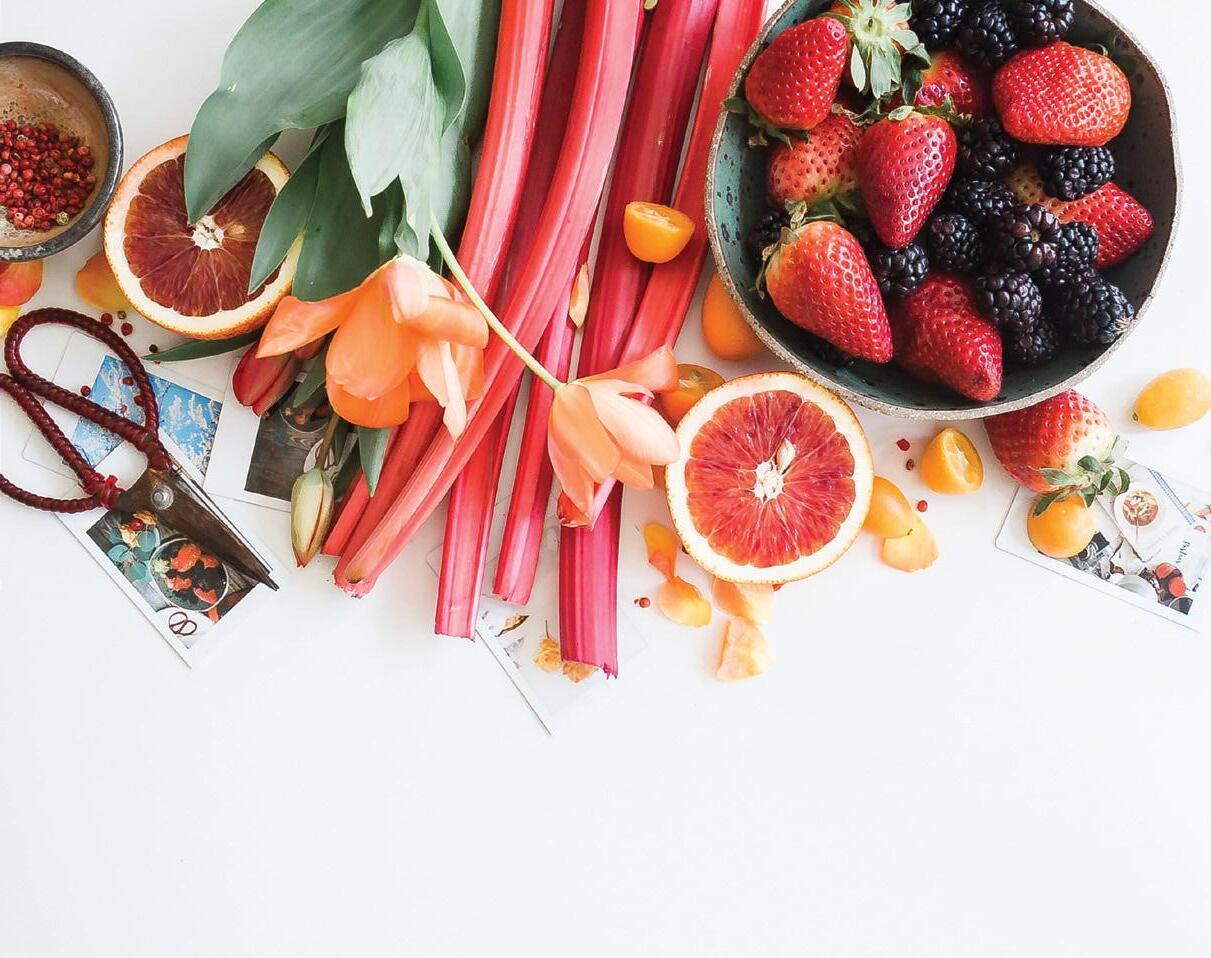
By Elaine Smookler
Every day, life presents us with a set of ingredients. It’s up to us to turn them into something delicious.
ABOUT
30 mindful October 2019 inner wisdom PHOTOGRAPH BY BROOK LARK / UNSPLASH
Elaine Smookler is a registered psychotherapist with a 20-year mindfulness practice. She is a senior faculty member at the Centre for Mindfulness Studies in Toronto.
MINDFUL AT WORK
An 8-week online course to enhance well-being, collaboration, and results


• Overcome stress and improve performance
• Enhance communication, compassion, and confidence

• Apply mindfulness to decision-making, teamwork, and leading change
• Cultivate a safe, respectful, and authentic culture
• Demonstrate mindful leadership
presents Focus.
Connect. Innovate. Focus. Connect. Innovate.
Learn more and register: eNaropa.us/mindfulness
www.MindfulnessCoachingSchool.com




EACH MOMENT OFFERS US A RICH SPREAD OF INGREDIENTS AND OPTIONS. WE MIGHT FIND SOME EXPERIENCES MORE DELECTABLE OR DESIRABLE THAN OTHERS, BUT IT’S UP TO US TO DECIDE HOW WE WORK WITH THEM, DOING THE BEST WITH WHAT WE HAVE.
and awkward in a social situation, try a few sprinkles of warmth and friendliness. If you notice exhaustion bubbling in the pot, you might fold in some mindful breathing, take a nap, or, if you have time, maybe enjoy a movie. We each have our own needs, our own tastes, our own knowledge and experience, and there is more than one way to compose a cassoulet. It’s all about staying tuned in to what’s cooking, and nurturing virtuosity in the balancing act of flavor and savor.
was able to see that I could soften it with the soothing milk of kindness. So I gave myself space to pause and take a mellowing, nutritious breath (and I reduced my caffeine intake for the day).

Just like with cooking, you invite deliciousness and mastery when you take a moment to assess the ingredients you have on hand before diving into the action. If you notice edginess, irritation, or anger in the mix, consider how you might moderate their impact—or even, when the time is right, let them shine with their characteristic zing. In the right proportion, edginess can be motivating. If investigated with kindness and nonjudgment, anger can signal a line that’s being crossed or that you need some self-care. The familiar taste of anxiety can be a reminder to reconnect with home and hearth, soul food, and soothing.
As you create your recipe for a nourishing day, you’ll want to check in with the seasoning, the textures, the balance of flavors, and adjust accordingly. If, say, you find yourself alone
One of the fun things about MasterChef is that the contestants aren’t professional cooks. They’re amateurs who aspire to develop mastery in a new field. Few of us are born chefs (except maybe Jamie Oliver). The rest of us have to learn how not to overmix the muffin dough, undercook the beans, or burn down the kitchen. Don’t worry if you find some ingredients more challenging to work with than others. Relax, focus on the main ingredient, and let yourself tinker and learn what works and what doesn’t. When you welcome whatever experiences arise you can relish them all, so eat, burn, and pray!
As you come to recognize the ingredients of your days, you might become aware of moments when certain encounters make you feel light as a soufflé, dark as chocolate, or as earthy as a mushroom. You can be there for it all, invite an abundant range of flavors, and develop a whole repertoire of tasty techniques to work with life’s sumptuous pantry of strange and familiar delights. ●
+1 505 906 6700
s 32 mindful October 2019 inner wisdom

BEING BORN INTO ONE RACIAL OR ECONOMIC GROUP OR ANOTHER OFFERS YOU GREATER OR LESSER ACCESS TO INFLUENTIAL NETWORKS
THAT CAN GIVE YOU THAT ALLIMPORTANT LEG UP.
Seeing the Truth of Inequality

We all want to believe that we’ve earned what we have. True equality begins when we’re willing to see how the circumstances of our birth have helped us along.
Back when my daily commute was a two-mile power walk through Manhattan, my idea of “fighting traffic” didn’t mean dodging cars or dashing across intersections seconds before a red light. It was more literal. When
ABOUT THE AUTHOR
Sharon Begley is senior science writer with STAT, a national health and medicine publication. She is also author of Train Your Mind, Change Your Brain and most recently Can’t Just Stop: An Investigation of Compulsions (2017, Simon & Schuster).
drivers sped through a yellow light and blocked my crosswalk, I’d pound on their trunk as I edged behind their bumper: “Nice going, idiot!”
And if they looked around for the culprit, they never suspected it was me. Female, white, middle-aged me.
Getting away with pedestrian road rage is the least of the privileges that age, sex, race, accent, or wealth bring. Being born into one racial or economic group or another—what group is privileged depends on the society, but most of the research focuses on the discrepancies between white and
Black people in North America—offers you greater or lesser access to influential networks that can give you that all-important leg up. Accidents of birth can improve or worsen the odds of growing up in a safe, clean neighborhood with good schools and cultural opportunities.
These “accidents” also determine your risk of someone calling the cops on you for driving while Black, barbecuing while Black, shopping while Black, or sitting in a college common room while Black, to mention a few recent news-making incidents. →
By Sharon Begley
by Edmon de Haro
34 mindful October 2019
brain science
• Illustrations



















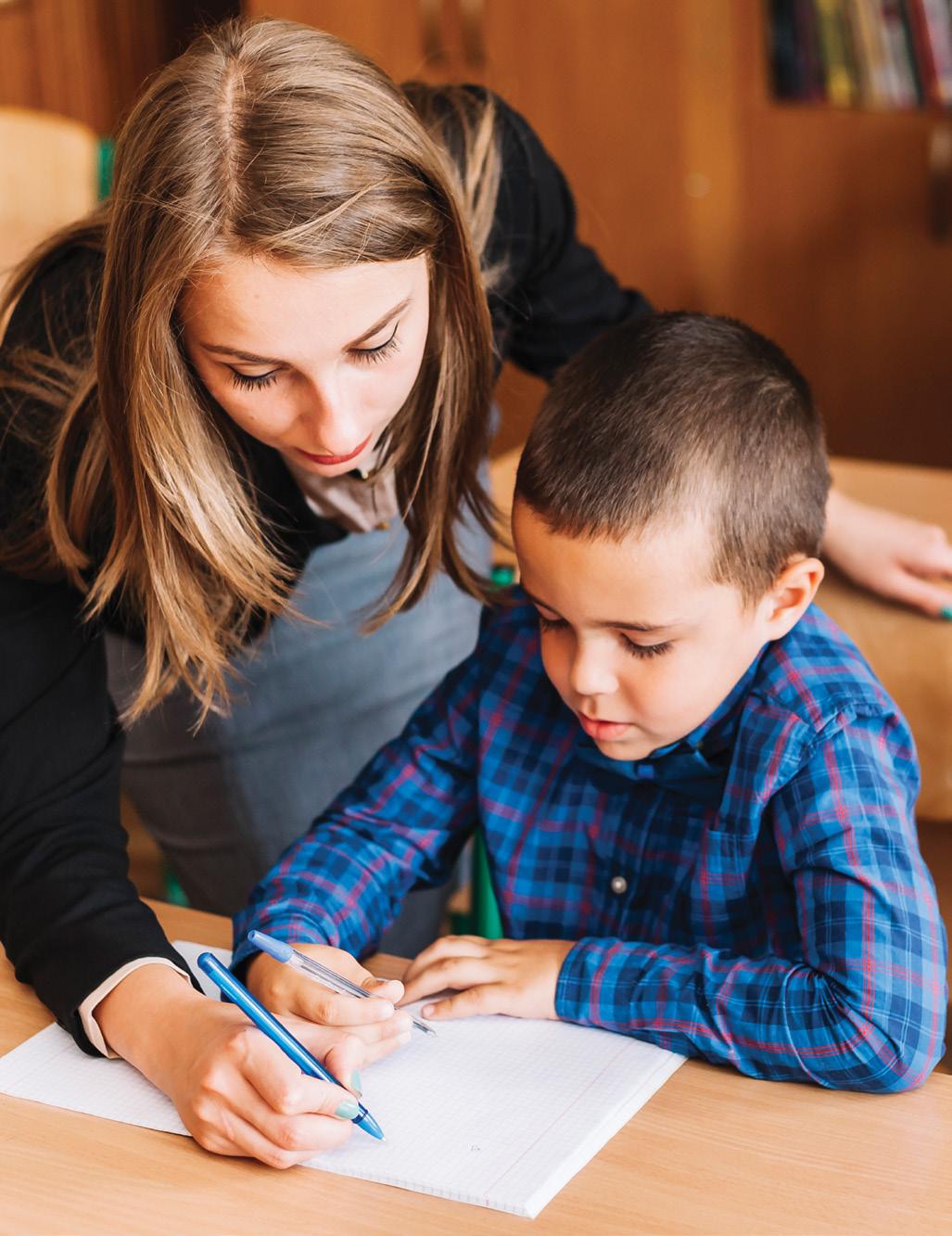











































































mindful.org/educators This project is generously supported by the Pure Edge Foundation FREE resources for teachers and parents Expert guidance on bringing mindfulness into the classroom Self-care practices to build resilience, focus and compassion Designed to meet teachers’ needs
Caring for teachers is caring for our future.
Unearned advantages go a long way toward explaining why white people in the US have greater life expectancies than Black people (79 years vs. 75.6), higher lifetime earnings, higher average wealth ($919,000 vs. $140,000), and higher median weekly earnings ($935 vs. $737). And is it really too much to wonder whether the taken-for-granted, rules-are-forlittle-people sense of entitlement that white people enjoy might have been a factor in the 2019 college admissions scandal, where it came to light that wealthy, privileged, mostly white parents had bought their kids’ way into Yale, the University of Southern California, and other selective colleges?
If you insist those real-world advantages have nothing to do with racial privileges starting at birth, but instead reflect your personal merit and hard work, keep reading and see what you think.
Born to Privilege
“Most whites are blind to the existence of racial privilege,” says psychologist Taylor Phillips of New York University. “They deny it exists.” In fact, 55% of white people in the US claim they suffer racial discrimination and that racial minorities enjoy privileges, according to a 2018 analysis by researchers at the Harvard T. H. Chan School of Public Health.
Of course, racial preference and affirmative action programs, aimed at improving minority access to education and jobs, exist. But countless studies have connected accidents of birth, especially race but also sex, to life’s outcomes. Some factors are measurable—think parental education and income (both of which usually favor white people) and neighborhood quality. Others are less so—for example, the ability to tap into networks of people (mom and dad’s friends, neighbors, parents of schoolmates) who can offer an edge and an in.
Phillips is one of the leading researchers trying to explain the causes of “privilege blindness.” This is a form of something psychologists call motivated reasoning, in which we perceive the world in ways that mesh with our personal beliefs about what is right and what we want to be true. A series of surveys has found that Americans of all races misperceive the wealth and income gaps between Black and white people: The average white family has twenty times the wealth of the average Black family, but participants guessed it was 80% smaller than reality, according to the work of psychologist Jennifer Richeson of Yale University. The least accurate guesses came from wealthy white people: They are motivated to believe society is fair, Richeson explains, since acknowledging the opposite would be to cast doubt on the fairness of their wealth.
Privilege blindness seems to spring from two deeply human urges: to
Editor-inChief Barry Boyce discusses contemplative ways to explore racism and white privilege and fragility with Rhonda Magee, Ramaswami Mahalingam, and Mirabai Bush on the Point of View podcast. mindful.org/pov m
 PODCAST Unpacking Privilege
PODCAST Unpacking Privilege
brain science 36 mindful October 2019
maintain a belief in one’s innocence and to feel meritorious.
In Western societies, particularly those that believe hard work brings success, people want to feel that their accomplishments are earned. “Meritocracy is how we justify unequal outcomes,” says Phillips. “We want to explain them as the result of hard work and talent.” That’s a difficult position to maintain if being white gives people a leg up. But class is another source of privilege that its recipients prefer not to acknowledge: The child who gets into Princeton because her father gave $5 million for a building is certain her success reflects merit, and the teens who got prestigious internships thanks to the intercession of their wealthy, powerful parents’ friends are sure they were the best candidates for the position.
In one experiment by Phillips and Brian Lowery of Stanford University, white participants completed a survey and read essays about racial inequality in America (specifically, white people’s advantages) and about childhood memories. They remembered many more “personal life hardships” compared to white volunteers who did not read the essays, including agreeing with such statements as, “There have been many struggles I have suffered,” and “My life has had many obstacles.”
“Whites respond to evidence of racial privilege by claiming their life was filled with hardships,” Phillips says. “We want to feel like we’re good people, which presents a conundrum when we’re faced with the existence of white privilege: It can make us feel that we didn’t earn what we have. So we say, ‘Privilege? What privilege?’”
In another study, Phillips and Lowery found that white participants who read about racial privilege and possible unearned advantage claimed to work harder than those who read a completely unrelated essay. “We’re all motivated by a desire to attribute our achievements to personal merit,” Phillips says.
Real-life experiments, not only laboratory ones, bear this out. People who win a job through contacts rather than hard work or merit “nevertheless claim that their personal effort was responsible for their success,” Phillips and Lowery wrote in a 2019 paper analyzing privilege blindness.
White Fragility
Research on blindness to white privilege coincides with the recognition of what author Robin DiAngelo calls “white fragility.” It means that white people “freak out” at the slightest reminders of racism, she argued in her 2018 book White Fragility: Why It’s So Hard for White People to Talk About Racism
DiAngelo reached that conclusion over the course of two decades running diversity-training workshops for US businesses, finding that white participants almost universally insist they are “color-blind,” talk about their minority friends, and boast of all their antidiscrimination activism. Challenged by unpleasant reminders of racism, they react with “anger, fear and guilt,” DiAngelo writes, as well as “argumentation, silence, and withdrawal from the stress-inducing situation.”
That, too, might drive privilege blindness, but while DiAngelo is nearly despairing about white fragility, Phillips is more sanguine. People can cast off their blinders and be mindful of the existence of white privilege, but mindfulness extends past merely correctly perceiving reality: It can facilitate introspection, causing us to question why recognizing racial privilege is so threatening to those who benefit from it, Phillips says.
Especially when a little introspection will likely reveal what some of us can get away with, due to our race and gender—well beyond pounding scofflaw cars. ●
REFLECTION
A LOOK IN THE MIRROR
Recognizing our own privilege starts with being dispassionately, mindfully open to the possibility that it exists. Some simple steps:
1 Ask yourself if you belong to a privileged group. Societies differ as to their privileged groups, but in general, Western societies privilege those who are white and wealthy.
2 In daily life, when you get away with something or get treated to a perk, ask if someone who looks different from you would have gotten the same treatment. For example, if you’re white, you probably won’t be hassled for loitering in an upscale store, complaining loudly in a restaurant, jaywalking, or committing some other social infraction.
3 Now think about whether privilege has brought you something more valuable than a store clerk’s tolerance. If you have benefitted from networking, academic or professional recommendations from influential people, or even good schools, ask whether you got them, at least in part, because of an accident of birth rather than because you labored hard for them. Not everyone who winds up on third base hit a triple.
October 2019 mindful 37

38 mindful October 2019
CHANGING THE NARRATIVE
Jenée Johnson shares how she is bringing mindfulness to the San Francisco Department of Public Health and encouraging meaningful conversations about race, trauma, and unconscious bias.
INTERVIEW BY VICTORIA DAWSON • PHOTOGRAPHS BY STEPHANIE DIANI
Jenée Johnson wants the San Francisco Department of Public Health—all 9,000 employees—to take a deep breath. And another deep breath. And another. She wants them—janitors and judges, IT technicians and social workers—to find, in those breaths, the opening notes of a mindfulness practice. Those moments of calm, she believes, are the foundation of emotional intelligence and its skills of resilience and compassion. In effect, Johnson’s title—Program Innovation Leader: Mindfulness, Trauma, and Racial Equity —positions her as the municipal agency’s chief mindfulness officer. In that capacity, she is bringing mindfulness into the agency’s ongoing work with trauma. That work includes mandatory training for every employee about the prevalence of trauma; how it can affect both the agency’s clients and its workforce; and how to take a systemic approach to foster wellness and resilience. Johnson also forged the agency’s partnership with the Googlebred Search Inside Yourself Leadership Institute, where she completed a nine-month teacher certification program. Previously, Johnson served for 15 years as the director of the agency’s Black Infant Health Program, incorporating mindfulness into her intervention work with mothers. Johnson lives with her husband in Oakland, where they raised their son.
October 2019 mindful 39
Tell me about the words in your title at the Department of Public Health: mindfulness, trauma, and racial equity.
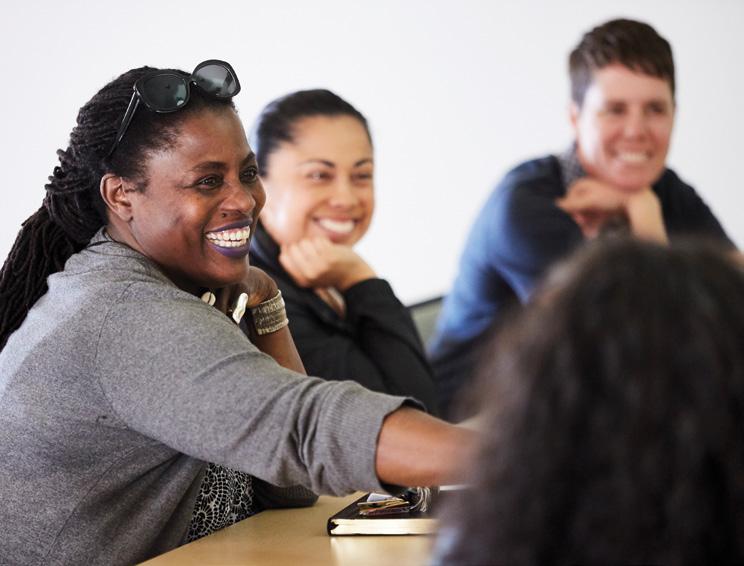
Trauma and stress are chronic public health issues. The department is saying we need to address the ways that trauma and stress affect us in the workforce, so that we don’t end up doing harm to each other and to the very people we seek to help.
And mindfulness?
We are hoping we can become a more mindful organization and that we can nest our trauma work in being present and conscious and kind. Learning to reset, recognizing unconscious biases, building resilience, helping the leadership be more compassionate—these are the things we want to encourage, through mindfulness.
What about racial equity?
Racism is a form of trauma. To begin to unravel the harm of racism—the historical trauma, the microaggressions, the white fragility that often is a barrier to conversation—people need to have a level of self-awareness, to be able to sit, without judgment, with what is uncomfortable, to be present and aware, and to hold this inquiry with curiosity and kindness.
ABOUT THE AUTHOR
Victoria Dawson is a freelance writer based in Washington, DC. She regularly contributes to Mindful

40 mindful October 2019 the mindful interview
My hope is that in becoming a mindful organization we will have greater focus, emotional balance, and the tools for the difficult conversations that need to happen. Being mindful—knowing and being in touch with what is going on with you—is essential to undoing racism.
A complex and bureaucratic organization like the San Francisco Department of Public Health does not seem like the most mindfulness-friendly setting. How do you maintain your inspiration?
Even within the confines of a bureaucratic system, I look for what is at the heart of human excellence. We work in an institution that is risk-averse, but we want to flourish. We want to do better for ourselves and for the communities we serve. We want to bring the fullness of our humanity to work.
What about trauma in your own life?
When I think of my own life, the thing that ends up being the most consistently traumatizing is racism.
Tell me more about that, will you?
Five or six years ago, I was in a small store—a home-lifestyle boutique— with my son. He was about 16 at the time, a tall Black boy wearing what all kids wear: a hoodie. We drifted to different sides of the store, and he was looking at the gadgets. I saw the store owner hone in on him, watching him intently. Is he profiling my child? “Hey, hi, that’s my son!” I said to the owner. We laughed it off. But my blood pressure went up, because I thought not about that particular moment but about all the moments when I would not be there to say, “Hey, that’s my baby, my boy, and he’s a good kid.” I know women who have lost their sons. I know them. Even before that incident, I had begun waking up in the middle of the night. My naturopath said my cortisol levels were high, and I connected that and the insomnia with the hypervigilance I felt I had to have, as the mother of
Jenée
Johnson on TraumaInformed Leadership
Learn how mindful leaders can help uncover and heal trauma.
mindful.org/ jenee
a young Black boy. I would blow up my son’s phone: Where are you? On the bus? Well, where’s the bus? How far away are you? Call me. Text me. Answer the phone. It was ridiculous. I had to address the anxiety that was running through me. I was like, “This cannot be my heritage, this lack of joy and constant worry. I’ve got to let go of this.” Mindfulness helped me to release—release it, Jenée—and to practice envisioning another way for myself and for my son.
What does mindfulness offer people of color?
For me, it’s a practice to rest and replenish and restore my humanity, which is one of the things that racism strips from you. My practice around mindfulness is a practice of reclamation—an African principle called sankofa, reclaiming what was left behind or what was lost. Mindfulness gives us the chance to rewrite that narrative. Mindfulness is a superpower. For people of color—particularly Black people—the practice of mindfulness becomes a protective factor. When microaggressions come at me, mindfulness offers me protec-
Top left: Jenée’s contemplative practice each morning includes journaling, where she writes down her reflections, gratitudes, and prayers for the day.
Bottom left: Colleagues participate in a Mindfulness Meet-up at the San Francisco Department of Public Health. Led by Jenée, these bimonthly meet-ups allow SFDPH employees to refresh their mindfulness practice, review concepts from mindfulness and emotional intelligence, and build community.
Above: One day of gratitudes that Jenée wrote in her journal:

“Discovering the potency of the feminine soul. Clarity and freedom in this decade. My loving son and husband. My work.
Freedom, calling my name...I answered. The power of nothing to hide, defend, protect.” The photo shows Jenée and her son Khalid in 2004.
tion. I don’t have to be caught up and reactive. I can have self-compassion, and that self-compassion builds my courage.
Can you give me an example or two? →
m
VIDEO
October 2019 mindful 41
I recently spoke at a conference, and afterward a white woman came up to me. “That was so great,” she said. “You’re a real ball buster!” No sister would ever say that to me. I had to say, “Excuse me? No, no, no.” I could have reacted with upset, but instead I chose to firmly correct her. That is where mindfulness came in: I chose my response. “I am not a ball buster,” I told her. “I am not a woman who annihilates men. That’s not who I am.” When a Black woman shows up in her fullness and her vibrancy, when her frequency is high, a narrative gets created: You’re too much. You’re too loud. You’re a ball buster. Not! It was so automatic for her to say that. That is what goes on, for us, every day. Another time, I’m in a department store with a friend, and we’re carrying bags—because we’ve spent quite a lot of money. We’re laughing, walking to another department—to spend more money!—and the security guard is following us. I look toward him and he looks me dead in my eyes. I looked back at him, stunned that this could be happening. After all, I had two shopping bags full of merchandise I had paid for.
In those moments, there is what Viktor Frankl called a space between stimulus and response. Do I choose
reactivity? Or do I take a breath, assess the situation, and then choose my response?
I paused, smiled at him, and kept going. I went on to enjoy the day with my friend. Sometimes my response has to have more teeth in it, but it is a response I get to choose, because I have a practice.
Do you have a daily practice?
I have a daily practice that includes prayer, meditation, and journaling, and often some scripture reading. Sometimes I’ll use a guided meditation. Right now, I really like the “Daily Calm” feature from the Calm app; sometimes I’ll just sit quietly with no guide. I journal—gratitudes or affirmations or desires. I usually do this in the morning, sitting at the kitchen counter, with a cup of hot water and lemon.
What are some of the deep roots of mindfulness in your own life?
The notion of being quiet and still was a part of what my family did. My family is from the Caribbean, and I would observe the elders just shutting things down and sitting quietly or lying down. When I visited my great-aunts in the Caribbean, they would say, “Let’s go take a sea bath.” I remember the first time one of my great-aunts said that. A sea bath? I wondered, What is that? You would just sit in the salt water—not swimming around, but just sitting, letting yourself be soothed by the salt water.
Mindfulness is a banner that gathers up different practices from a variety of cultures. It’s not just for one culture. The human breath belongs to the human being.
Black people have been practicing mindfulness forever. Think about the Montgomery bus boycott and how people walked for nearly a year, gathering each night at churches to sing and pray, so they could walk the next day. That’s mindfulness. Think about the young people who integrated the lunch counters and
trained themselves to maintain their composure. They sat at the counters while people poured food and drinks over them and they maintained their equanimity.
Can you say more about mindfulness as a tool for people of color?
We know that deep relaxation is important for healing, but how do we replenish ourselves? And rest? When you poll Black women, you find that we don’t rest well. Remember, we were brought here to work! I recently said to someone, “I have been tired for years.” Mindfulness helps us to rest—to stop, sit, connect with our breath, close our eyes, drop our gaze, sit upright but relaxed, be still. That’s what mindfulness gives us—a chance to get quiet and see what’s there and to hold it kindly. This is the exploration of being human. For people of color, Black people in particular, our identity is constantly defined vis-à-vis white folks. Well, this quietness is putting an end to that: I am sovereign of myself. Who I am and how I define myself is not visà-vis white folks anymore.
This is also a YouToo movement. The same way that I’m tapping into courage, white people can tap into courage and end this hollow compassion that shows up when they see Black pain, so they can go deeper and make some decisions about how they engage in a truly more meaningful way.
What do you mean by hollow compassion?
Hollow compassion is the result of white people not having the courage to face their own racialization and the harm it has caused. Land-grabbing. Genocide. Enslavement. Colonialism. Imperialism. All these things that white domination has forwarded and that white people are benefiting from here and now. Compassion comes from owning that and sitting with the discomfort of that, so we can then generate something different.
When I talk about mindfulness for Black people, I am looking at it as →
“MINDFULNESS IS A BANNER THAT GATHERS UP DIFFERENT PRACTICES FROM A VARIETY OF CULTURES. IT’S NOT JUST FOR ONE CULTURE. THE HUMAN BREATH BELONGS TO THE HUMAN BEING.”
42 mindful October 2019 the mindful interview
Jenée Johnson
mPODCAST Unpacking Privilege
Editor-in-Chief Barry Boyce discusses contemplative ways to explore racism and white privilege and fragility with Rhonda Magee, Ramaswami Mahalingam, and Mirabai Bush on the Point of View podcast. mindful.org/ pov
Jenée and her son, Khalid Edwards, 23, near their home in Oakland, California. A meditator himself, Khalid prefers to meditate outside in nature. From time to time, he and Jenée also practice together, often in their living room or kitchen.

October 2019 mindful 43
INFINITE AS THE UNIVERSE
Mikael Chukwuma Owunna is an award-winning, queer, Nigerian-Swedish artist, photographer, Fulbright Scholar and engineer, born and raised in Pittsburgh, Pennsylvania. Much of Owunna’s creative work explores and celebrates identities among Black, immigrant, and LGBTQ communities. The photo project seen here, Infinite Essence, came into being through a creative synthesis of his biomedical engineering and photography expertise.
“I’ve set about on a quest to recast the Black body as the cosmos and eternal,” Owunna explains on his website. “I hand-paint the models’ bodies with fluorescent paints, and using
my engineering background I have augmented a standard flash with an ultraviolet bandpass filter, to only pass ultraviolet light. Using this method, in total darkness, I click down on the shutter— ’snap’—and for a fraction of a second, their bodies illuminate as the universe.” His print medium is aluminum, “to reflect on millennia of West African metallurgy traditions and to connect the sitters to the ancestors.”
Odinani, the spirituality of the Igbo people—native to the region of southeastern Nigeria—also figures into Owunna’s series: “We believe in the existence of a ‘chi’ in every person. So just as you are seated reading this and
I am here, speaking to you through the page, on the spiritual plane, our spirits, our chis are also convening together. Ultraviolet light is not visible to the human eye, and so we can illuminate and find—albeit temporarily—the unseeable therein, the soul, the chi. It is on this plane of existence where, regardless of our experiences of oppression on the physical plane, we are infinite.”
—Amber Tucker
sankofa—the principle of going back and reclaiming what you left—but it’s also an opportunity for us to stop doing the heavy lifting, to take off the burden and lovingly hand it over to white human beings and say “You have some work to do.” My work is to heal. And your work is to take a look at this stuff that is really hard, and I’ll hold the space and when you get done we can come back and have this conversation.
What does that look like?
It ultimately requires some kind of action. You know when something’s hollow, it’s empty, right? It’s just a facade of compassion. Part of what compassion looks like is doing your own work, because white people have also been racialized.
What is needed for Black people to heal from the harms of racialization?
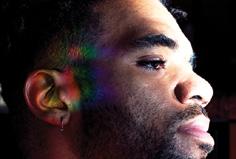

You know that old experiment about the dolls: You show kids a white doll and a Black doll and ask who’s the bad doll. All of the kids, including the Black kids, point to the Black doll. But that’s the color of their skin and you see their little faces trying to make sense of this disruption. So what has gotten internalized? That’s our work as Black people: to undo the internalized oppression. That’s the lane I occupy with mindfulness. Get free and be fully human.
How do people do that?
First thing I always start with is know the history. And tell the truth
about what happened. When you start with the history and have the courage to really face that, then it’s hard to be hollow.
For example, [for assimilated immigrants who pass as white], you’re coming in and stepping on the backs of Black people. Your ethnic identity fades to the back and you step in to the power and privileges that whiteness is set up to have. Until we tell the truth about that, how are you going to dismantle, disrupt, and recreate? You can’t put the good on top of the bad. You have to tell the truth about it.
What about the idea that “pain is pain”? Why differentiate by skin tone— isn’t that just perpetuating divisiveness when we should be looking for our common humanity?
ILLUMINATE
44 mindful October 2019
Mindful learned about Mikael Owunna’s Infinite Essence project through Jenée. We saw how it visually captures Jenée’s loving reclamation of mindfulness as liberatory for Black people. Jenée says that she and Owunna “are kindred in our respect and love of Black life. I love how the series uplifts Black people. I love how Mikael wraps us in stars and reclaims our Divine essence.”
Well that’s part of the white fragility conversation. Is it true that pain is universal? Yes, it’s true. But is it not also true that there’s been very deliberate and aggressive white domination worldwide? Just look at the historical acts and facts and the harm that’s caused. And if you don’t want to look at that, fine, but that doesn’t mean that it’s not so.
Mindfulness can be powerful for white people to examine their own racialization. To look at the history full-on and then make some decisions about how they want to proceed.
Once you sit in it, then solutions to correct and repair will arise. The question to ask is How can I be of service? That’s for you to discover. Not for me to prescribe. But the first thing is you’ve got to face it. And if you keep

running away from it and keep running these stories about ‘my people suffer too,’ then we’re never going to get anywhere. Everybody’s people have suffered. We know that human suffering is universal.
One of the things that I have gotten from this practice of contemplation, quieting, prayer, meditation, and aging is knowing what’s your work, what to take on, when to say ‘I’m not doing that, but this I can do.’ Just moment by moment making those decisions. I am committed to having the joy of life.
For me, the key is to know what is mine to manage and what is not. For Black people—for Black women particularly—it’s time to stop carrying the burden that’s not ours to carry and to move more fully into our joy.
As I think about it, “Program Innovation Leader: Mindfulness, Trauma, and Racial Equity” sounds like far more than just a job title or 9-to-5 project for you.
For me, it’s such a bigger and deeper conversation than what is happening at work—that’s really just a small part. What I am here to do is to equip my people with tools and practices and skills. Emotional intelligence is trainable, and it’s helping us to be better and stronger. These practices don’t belong to any one group. They are in the human field, and we get to pick those flowers and arrange them in a way that works for us. That’s what I’m really up to. ●
October 2019 mindful 45

46 mindful October 2019
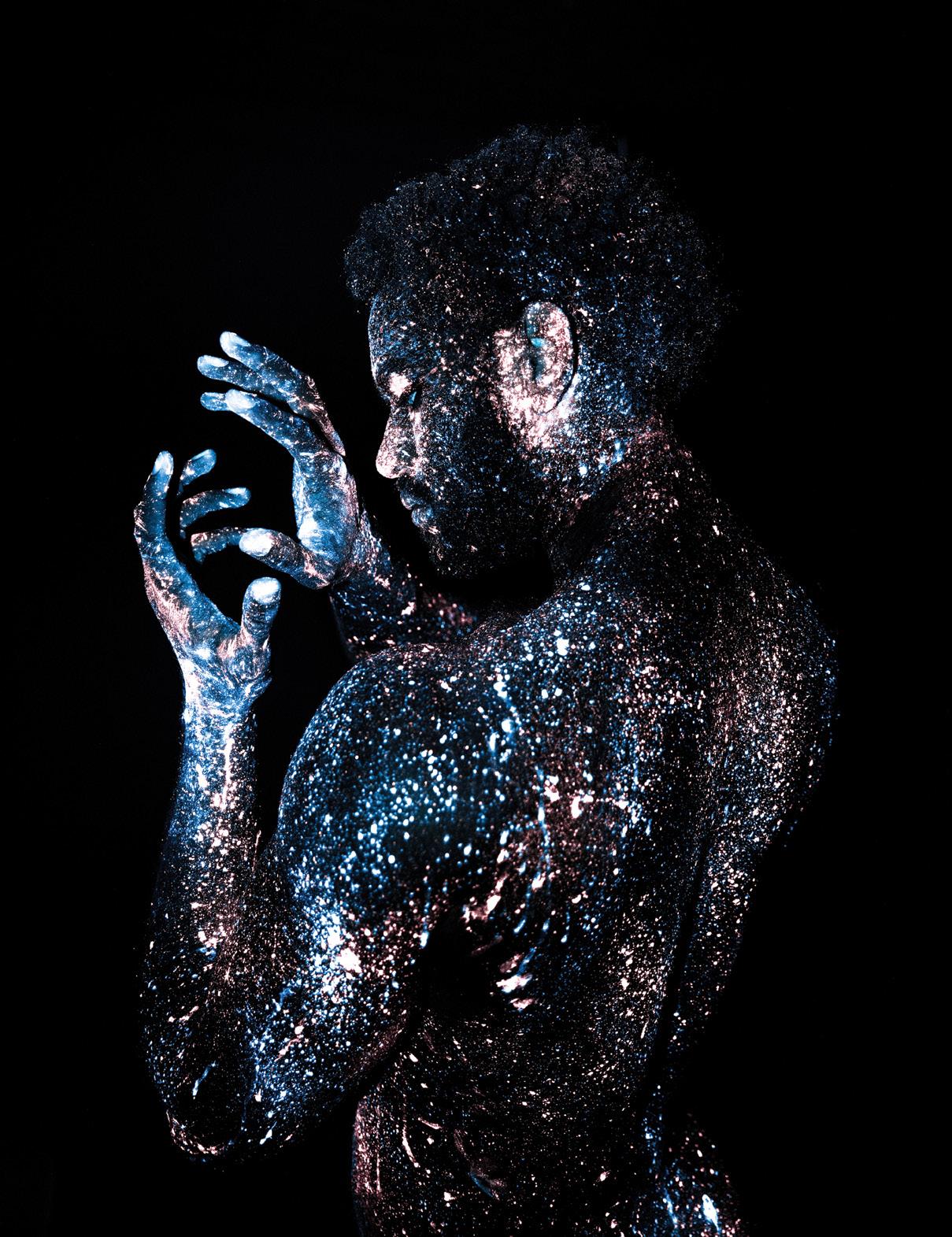
October 2019 mindful 47
Lean In
Persevering in the face of adversity—and getting back up when you stumble—are essential to thriving in tough times. No matter where you start, you can train your brain to build resilience.
BY LINDA GRAHAM
It’s one thing to misplace your keys or your wallet two minutes before you have to rush out the door for work. You do your best to breathe slowly, stay calm, and try to think if maybe you were wearing something else with pockets before the early morning mad dash. We all experience these hiccups in life—dropping the lasagna on the way to serve guests, leaving a laptop on a plane, learning that the car needs a new transmission—and these hiccups can create quite a startle in the nervous system. Our capacity to cope with these inevitable ups and downs is then further tested when we layer on our own critical messages: “You stupid klutz!” or “I can’t ever get anything right” or “I knew it.”
PHOTOGRAPH BY
AARON THOMAS / STOCKSY
48 mindful October 2019 resilience

But usually we can right ourselves again. We put on our big-kid pants, face the distress of the moment, and deal.
Occasionally we are called on to deal with greater troubles and adversities, not just hiccups but earthquakes that overwhelm our capacities to cope, at least temporarily. They include troubles like infertility or infidelity, a diagnosis of cancer, losing a job several years out from retirement, a child arrested for selling pot, or a son wounded in combat overseas. When these bigger bumps happen, we have to dig deeper into our inner reserves of resilience and our memories of times when we’ve successfully coped before, while also drawing on external resources such as family and friends. Here, too, finding our way back to our center, our inner equilibrium and ability to cope, can be more difficult if we are told we are—or perceive ourselves as—less than capable, less than skillful, less than good enough, or unworthy of help.
And then there are times when too damn many disasters happen all at
once: We lose a child in a car accident, or cause a car accident, at the same time that an aging parent has a stroke and a freak thunderstorm causes flood damage to half the house. When catastrophes like these strike, we are vulnerable to losing our resilience altogether, temporarily or even for a long time. If we have experienced too many unresolved traumas in the past, we can be especially susceptible to falling apart and not being able to recover. When our reserves are already depleted, we can begin to feel like we’re just barely afloat and about to go under.
How in the world do we bounce back from traumas like these? By strengthening our resilience.
Resilience—the capacity to bend with the wind, go with the flow, bounce back from adversity—has been pondered, studied, and taught in tribes and societies, in philosophical and spiritual traditions, and through literature for eons. It is essential to the survival and thriving of human beings and human societies.
Taking In the Good
1
Pause for a moment and notice any experience of kindness, gratitude, or awe that you have experienced today or remember from the past. Maybe your neighbor drove you to and from work for three days while your car was in the shop, or you saw a blue heron rise up from a pond at dusk.
2
Attune to the felt sense of the goodness of this moment—a warmth in your body, a lightness in your heart, a little recognition of “Wow, this is terrific!”
3
Focus your awareness on this felt sense of goodness for 10–30 seconds. Savor it slowly, allowing your brain the time it needs to really register the experience and store it in long-term memory.
4
Set the intention to evoke this memory five more times today. This repeats the neural firing in your brain, recording the memory so you can recollect it later, making it a resource for your own sense of emotional well-being, and thus strengthening the inner secure base of resilience.
ABOUT THE AUTHOR
We now also know that resilience is one behavioral outcome of a mature, well-functioning prefrontal cortex in the brain. Importantly, whether we’re facing a series of small annoyances or an utter disaster, resilience is teachable, learnable, and recoverable. It takes practice, and it takes awareness, but that power always lies within us. →

As you experience and re-experience the moment, register that not only are you doing this, you are learning how to do this. You are becoming competent at creating new neural circuitry for resilience.
—Linda Graham
PRACTICE
50 mindful October 2019 resilience
Linda Graham is a licensed marriage and family therapist and mindful self-compassion teacher in the San Francisco Bay Area. She is also author of The Resilience Toolkit (New World Library, 2018).
mONLINE PRACTICES
5 ScienceBacked Strategies to Build Resilience
These resilience practices can help you confront emotional pain more skillfully. mindful.org/ resilience

PHOTOGRAPH BY NEMANJA GLUMAC / STOCKSY
When the selfregulating capacity of your brain is functioning well, you can inhabit or quickly recover a felt sense of centeredness, ease, and well-being after an upsetting event.
October 2019 mindful 51
Tune In to Act Wisely
The practices of attending and attuning will begin creating the space to help you respond to emotions in a new and more resilient way. Regular practice will make it easier to shift from negativity to positivity. Apply the principle of little and often. Practice again and again until these skills become the new habits of perceiving and responding to your emotional landscape. Then you can choose your response.
ATTENDING
This practice can deepen your capacity to become present to and consciously aware of your experience without needing to leave or push it away to maintain your emotional equilibrium.

1
Sit quietly in a place where you won’t be interrupted for at least five minutes. Come into a sense of presence, knowing you are here, in your body, in your mind, in this moment, in this place.
2
Whatever body sensation, feeling, or thought comes up, simply notice it, acknowledge that it has shown up on your radar, allow it to be there, and accept that it is there. At this point you’re not wondering about it or trying to figure it out, just attending to it enough to register the experience in your awareness.
3
At this stage in the exercise, you have come to a choice point. You can let go of attending to the experience of the moment and refocus your attention on the quiet, spacious awareness, or you can attune to the felt sense of the experience to decipher its message.
ATTUNING
This practice entails discerning the particular flavor of an emotion. It helps you learn to label complex, subtly nuanced emotions, such as those of feeling lonely or suspicious, which builds your emotional literacy. 1
See if you can identify any feeling or sensation in the experience you were attending to in your body. Begin to label it—shaky, tight, churning, bubbling, contracting, expanding. Try not to create a story about it. Just feel it and name it.
2
Sometimes it’s a challenge to put your finger on the exact nuance or flavor of the message. So just try to find a good enough label for now: “This is contentment,” “This is aggravation,” or “This is despair.”
Whatever feeling you are attuning to, and however you choose to label it, this feeling is what it is. All you have to know at this point is that you can know what it is and label it in a way that is useful to you. You can trust in your ability to know and label a feeling even if you change your mind later about what it is. Once you can name an emotion, you are on the way to making sense of it and taking wise action toward dealing with it.
—Linda Graham
PRACTICE 52 mindful October 2019
YOUR FLEXIBLE BRAIN
All of the capacities that develop and strengthen your resilience—inner calm in the midst of the storms, seeing options clearly, shifting perspectives and responding flexibly, choosing actions, persevering in the face of doubt and discouragement—are innate in your being because they are evolutionarily innate in your brain.
Neuroplasticity means that all the capacities of resilience you need are learnable and recoverable. Even if you didn’t fully develop your capacities for resilience in early life, you can develop them now. The neural networks underlying your coping strategies and behaviors can be shaped and modified by your own choices, by self-directed neuroplasticity.
This requires the engagement of the prefrontal cortex, the center of executive function in the brain. It’s the structure we rely on most for our planning, decision-making, analyses, and judgments. The prefrontal cortex also performs many other functions essential to our resilience: It regulates function of the body and the nervous system, manages a broad range of emotions, and quells the fear response of the amygdala. (That quelling is essential for resilience!)
We now know that experience is the catalyst of the brain’s neuroplasticity and learning for our entire
lives. At any time, we can choose the experiences that direct the brain’s learning toward better functioning. Resilience can be diminished (for example, by the impact of acute trauma) or strengthened (through the perception of safety; by being understood and accepted by another person; through conscious reflection, such as mindfulness; and with the cultivation of positive emotions) at any time by experience.
HOW EMOTIONS IMPACT RESILIENCE
Just simply being alive evokes emotions. We experience one emotion after another every single moment of the day: delight in watching a sunrise, frustration at getting stalled in traffic, resentment when a coworker takes credit for an idea we came up with, terror for the future when a spouse or child gets a life-threatening diagnosis.
Whether we like having these emotions or not, whether we trust them or know what to do with them or not, our feelings constantly filter our perceptions and guide (or sometimes misguide) our responses to all of our experiences. In that way, our emotions play an integral role in our resilience.
When the self-regulating capacity of your brain is functioning well, you can inhabit or quickly recover a
felt sense of centeredness, ease, and well-being after an upsetting event. You regain your equilibrium. From there you can perceive clearly what’s triggering your emotions and discern what a wise response to those triggers would be.
For example, we know it’s not resilient to be hijacked by floods of emotions: You can’t think straight, and your responses may be useless or harmful. And it’s not resilient to try to repress your emotions. For one thing, it takes an enormous amount of physical and psychological energy to do that, energy you would be better off using to respond to the situation or to other people wisely. Secondly, when you try to repress any specific emotion (anger, grief, and shame are common targets), you can wind up damping down all of your emotions, even the helpful ones. You can go flat in your being and lose the motivation to do anything at all.
TAKING BACK THE REINS
What you can do instead is learn to manage surges of negative emotions and intentionally cultivate
positive ones, such as kindness, gratitude, generosity, delight, and awe. Positive emotions shift the brain out of the contraction and reactivity of the negativity bias, into the receptivity and openness that increase your response flexibility. The direct measurable outcome of these practices is resilience.
Focusing on positive emotions is not meant to bypass or suppress dark, difficult, afflictive ones. Your experiences of angst, pain, and despair are very real. But you can learn to acknowledge, hold, and process those emotions. You broaden your habitual modes of thinking or acting and build enduring, resilient resources for coping. These include increasing social bonds and social support and deepening insights that help place events in a broader context. You find a way through, and come out the other side.
All emotions—the ones you dislike and dread as well as the ones you welcome and enjoy—can guide your behaviors in resilient selfprotecting or self- enhancing ways. You don’t have to be afraid of your emotions, be stuck in them, or be swept away by them. You do have to take responsibility for how you experience and express them. ●
Excerpted from the book Resilience: Powerful Practices for Bouncing Back from Disappointment, Difficulty, and Even Disaster. Copyright ©2018 by Linda Graham. Printed with permission from New World Library— www.newworldlibrary.com.
 PHOTOGRAPH COURTESY OF JILLIAN PRANSKY
PHOTOGRAPH COURTESY OF JILLIAN PRANSKY
PHOTOGRAPH BY MILLES STUDIO / STOCSKY October 2019 mindful 53 resilience
Let It Be
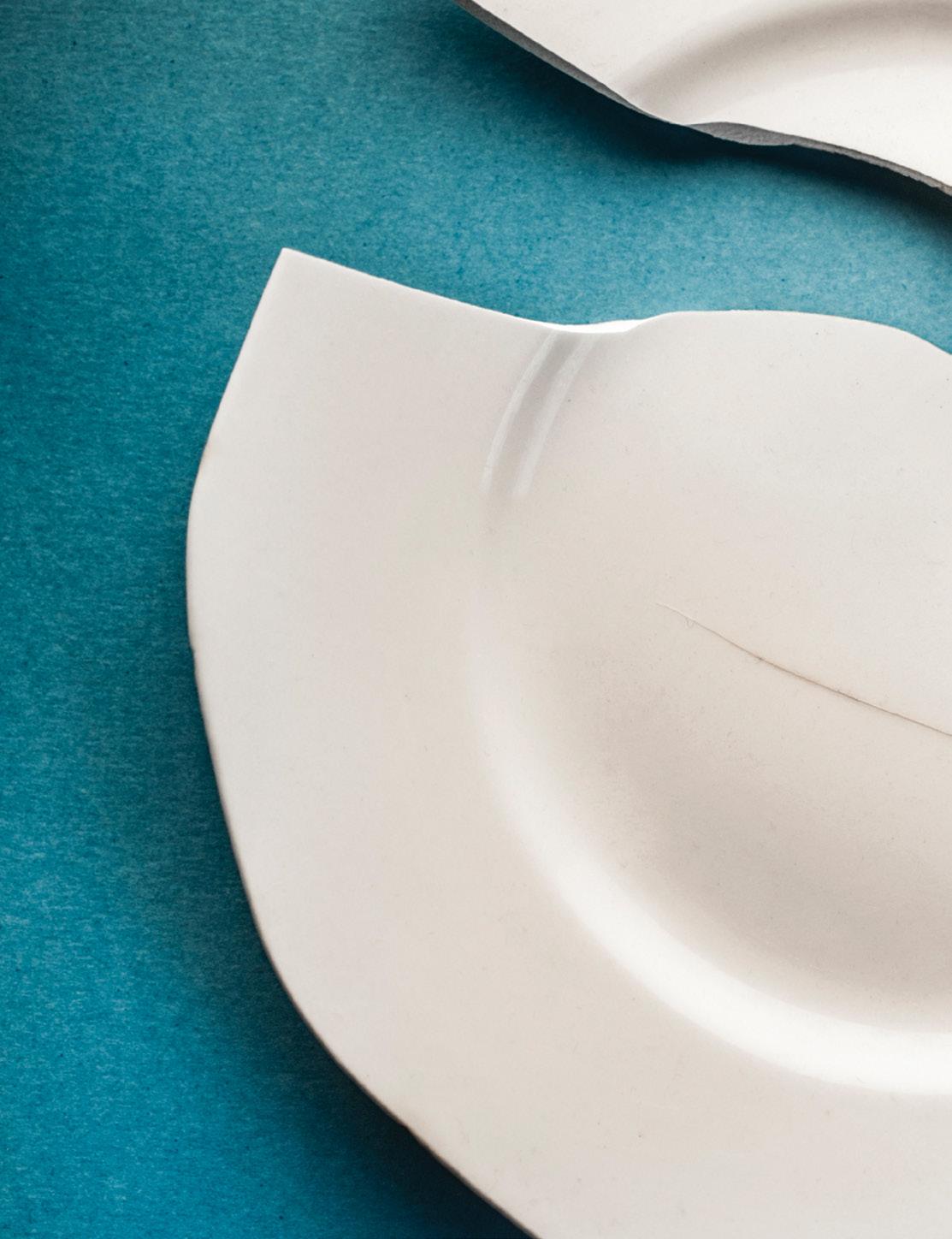
PHOTOGRAPH BY PLAINPICTURE / REILIKA LANDEN
If there’s one thing life teaches us, it’s that nothing stays the same. Yet we find all sorts of ways to resist, deny, and avoid this reality. Editor-in-Chief Barry Boyce offers nine perspectives to help us make friends with change.
ABOUT THE AUTHOR
54 mindful October 2019 acceptance
Barry Boyce has been an avid mindfulness practitioner for over 40 years and is co-founder of Mindful and Mindful.org.
When I first started meditating, I was anxious and fidgety. I wanted to crawl out of my skin. I’m truly astounded that I didn’t quit, since I was 17 at the time and had quit all sorts of things in those days—and they were mostly things that were good for me. Things that weren’t good for me, I just kept on doing. But somehow I did keep going with meditation. Maybe it had something to do with peer pressure or pride, or just the notion of how silly it would be to chuck the whole thing aside because I couldn’t pay attention to my breath without going just a little bit crazy. Also, meditating confirmed that you were not part of the mainstream, and not being mainstream was a part of my thing back then (#sixties, which didn’t end till the middle of the seventies).

Stick-to-it-iveness, or stubbornness, or whatever it was, paid off, because meditation soon became a regular and important part of my life. A lot of the agitation died down (although it’s still there in a big way at times) and I began to sense a backdrop of well-being that lay behind all experiences. Nice.
And yet, this chill quality started to be married to ambition, trying to become a good meditator, hell, a great meditator. I filled my head with fantasies of how wise and measured I would be, maybe even holy, but certainly someone whom people would look upon as a sage, the one who is the calm center in the midst of the storm. In terms of my actual demeanor and behavior, this was far from the case, as anyone who knew me in my early days will tell you. →
October 2019 mindful 55
There’s an inner being inside us all, it seems, who wants to take the path of least resistance, avoid doing the dirty work, and be lauded nonetheless. I’ll call him Frank (with apologies to all the Franks out there). Frank makes a big mess. When inner Frank takes over, it’s as if a wild boar got drunk and imagined he could safely interact with humans in polite society. Frank thinks he’s so suave and debonair, but he’s thinking only of himself, and he’s therefore oafish and inconsiderate of others—like the “Two Wild and Crazy Guys” in the Steve Martin and Dan Aykroyd Saturday Night Live skit. (Check it out on YouTube if you haven’t seen it or it’s faded from memory.) When that ambitious lout inside of me took hold, I feel pretty certain I became arrogant, clumsy, and at times intolerable.
Eventually, though, like the skin-crawling agitation that dominated my early forays into meditation, the self-importance and ambition started to lessen and weaken. It became not only tedious to others but tedious to me. And yes, like the agitation, it could rear its ugly head at any time, probably even as recently as yesterday, but all in all, trying to win the meditation Olympic Gold Medal has been much less of a feature of what you might call my meditation “career.”
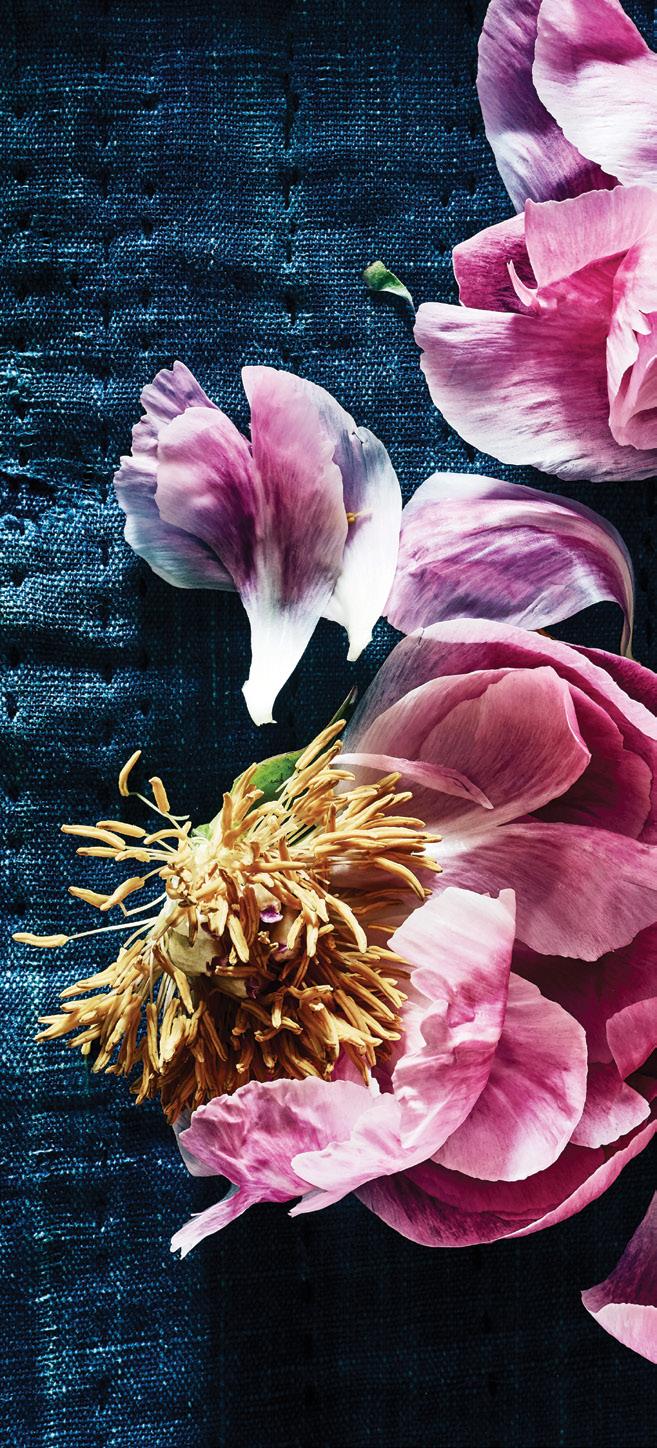
What became a bigger feature is a seemingly insatiable curiosity about why I (and we, I suppose) cling so tightly to the notion that things ought not to change, that they should stay just like they are, that the status quo ante (i.e., how things have been) is the best status of all. We adhere to this belief and desire in spite of massive evidence to the contrary every single day, if not every minute, of our lives. Staying the same is not what’s going on here.
Flux is the thing.
And yet, I find, I still expect things not to change, many decades into my examination of this intractable habit. There are explanations having to do with the fact that it can be a helpful mental shortcut to expect things to stay the same: to believe that there will be a floor under our feet when we swing out of bed in the morning; that when the light turns green, people will go; that my baseball team will once again not go to the World Series and that my wife will mock me for giving a damn about that. Indeed, there are common-sense reasons for what psychologists call our status quo bias, and yet in the context of figuring out the ways we cause ourselves pain, putting forth reasons for relying
56 mindful October 2019 acceptance
PHOTOGRAPH BY PLAINPICTURE / DAVID PRINCE
on things staying the same really amounts to no more than making excuses, in my mind, for our deep clinging to the familiar, our allegiance to permanence, our fear of change.

Somewhere along the way, though, the why part of this quest started to recede into the background. It seemed a waste of time to keep trying to resolve a conundrum that eluded me for as long as some middle-aged people have lived. A better approach might be to take it for granted and see what could be done to undercut and confound it.
Some people call this allowing practice, just letting things be, and in my experience, there can be a number of allowing practices. The trick, though, is for the allowing practices to not be about a begrudging allowance, à la “OK, things change. I get it. So, can we get on with the familiar, already?” Calling these “practices” makes it a bit fancy, I admit. They are simply reflections in the midst of life: taking the opportunities presented to us to acclimate to the big, beautiful, changing scene that life serves up.
Since these nine reflections focus on the minutiae of life, things that might even normally be beneath notice, one could argue that they’re not that relevant to the kinds of change that deeply bother us: losing or not getting a job, having our hopes dashed, the death of friends and family, the fact that we will die.
Fair point. These big life events are the emotional touch points where our difficulty with change—our feeling of time passing, that everything moves on and slips through our fingers—makes itself most acutely felt. For that very reason, though, these are hard to tackle head-on. Interrupting the momentum of our discomfort with change in the small things can, over time, subtly alter our perception of the big things. In some ways, this is indeed at the heart of mindfulness: When we rest patiently, with no goal, aim, or destination for a while, we turn a microscope on the shifting landscape that emerges anew with each passing moment. →
October 2019 mindful 57
Allowing does not mean negating what is painful. It is allowing what is there to simply be there.
Welcome Everything, Push Away Nothing
Explore acceptance in your mindfulness practice by embracing curiosity and fearless receptivity.
 By Frank Ostaseski
By Frank Ostaseski
To welcome something doesn’t mean we have to like it, and it doesn’t mean we have to agree with it; it just means we have to be willing to meet it. We temporarily suspend our rush to judgment and are simply open to what’s occurring.
With welcoming comes the ability to work with what is present and what is unpleasant. After a while, we begin to discover that our happiness isn’t determined simply by what is external in our life but also what is internal.
To be open means to embrace paradox and contradiction; it’s about keeping our minds and hearts available to new information, letting ourselves be informed by life. Openness welcomes the good times and the bad times as equally valid experiences.
Openness is the basis of a skillful response to life.
At the deepest level, this is an invitation to fearless receptivity. To welcome everything and push away nothing can’t be done as an act of will. This is an act of love.
Mostly, we think of mindfulness as bringing a very precise attention to what’s happening, as it’s happening. In this way, we bring an almost laser-like attention to our practice. We bring a careful moment-to-moment attention to sensation, to thoughts, to emotions. But sometimes this kind of precise attention can create a sort of tension or struggle in the mind. This is when it’s more useful to try a practice that cultivates an open, boundless awareness. To develop a mind that is vast like space. To allow pleasant and unpleasant experiences to appear and disappear without struggle, resistance, or harm.
So, let’s try this practice for welcoming everything and pushing away nothing.
Settle back into your seat, relax, and come into the breath and body. Maybe let your eyes close if that feels comfortable for you. Let your breathing be very natural.
Begin by being aware of the various sensations in your body: pressure, movement, tingling, the feel of the air on your hands and face. Just feel the waves of sensation.
Now, let go of the idea of arms and legs and a body. Become aware of the area above your head. How far does that space extend? Let your awareness sense what’s to the left of you. What’s to the right of you? Let your awareness come into the area below your body. Is there any vibration in your feet or the floor? Let your awareness extend to the area behind your body, so it fills the whole room. Let your awareness be aware of what’s in front of the body, extending out as far as it possibly can, so that there’s this sense of openness, of boundless space; and all of the activities of body, heart, and mind are appearing and disappearing in that open, welcoming space.
m
US Mindful30
JOIN
Join Frank Ostaseski and other Mindful luminaries for our 2019 Mindful30 event.
Sign up at mindful.org/ m30
PRACTICE 58 mindful October 2019
Allow all experience to arise without any interference— no inside, no outside. Relax your ownership of thoughts. Look and see the difference between being lost in thought and being mindful of thought. It’s like when a sound occurs in the room, or a bird flies by, you just notice the sound of the bird; you don’t think it’s you. Let it be that way with your thoughts and sensations, everything coming, everything going in a vast, open space. It can be helpful to think about what happens when you walk into a room: Most people see the chairs or tables or the objects in the room and fail to see the space.
Let yourself be aware of the space surrounding all the activity, all the coming and going. Remember, whatever we can give space to can move. Keep allowing all the thoughts, all the sensations, all the feelings to rise and disappear in the vast spaciousness, like clouds in the sky.
Finally, let your attention come to the awareness itself, vast, transparent, clear, not disturbed by anything that’s coming and going. Welcome everything, push away nothing.
ABOUT THE AUTHOR
Frank Ostaseski, leading expert in contemplative end-of-life care, is the cofounder of the Zen Hospice Project, founder of the Metta Institute, international lecturer, and author of The Five Invitations: Discovering What Death Can Teach Us About Living Fully

Plant Life
IF YOU TAKE a close look at plastic flowers and then compare them to living flowers, what’s the salient difference? It’s that the living flowers are also dying flowers. The very fact that they have a life span and you can see that change before your eyes is key to their beauty. When you can, take a little time to observe the fragility of a flower. Even a silk flower fades in the sunlight and a plastic flower will eventually become brittle.
Seasons
SOME PLACES HAVE four very distinct seasons. In other places, the seasonal change is subtler, but no place on Earth is without seasonal changes in temperature, light, precipitation, plant life—providing an excellent opportunity to revel in the changes. One Japanese approach to nature and food even divides the year into 72 micro-seasons, of about five days each. (And yes, there is an app for that.)
Next to my desk is a wide, tall window, and I make sure to look out from it each day and check out the seasonal change. In early spring, the branches are bare, in midspring they are spare, by late spring and summer, they hang down from the weight of leaves, blossoms, and seeds. In autumn, they are colorful. In winter, they are skeletal.
Light
FOR YEARS, MY brother lived on the side of a mountain. When I would visit him, I used to love to sit on his porch as late afternoon gave way to evening and nighttime. We tend to think of the color of something we see as fixed, but it is not. Colors change all the time in relation to light. In bright light, the trees on my brother’s mountain are mostly bright green. As the light fades, they are dark green, and then black, no more than a silhouette. Are we not just the same, not one color, but many colors? →
PHOTOGRAPH BY DEEPOL BY PLAINPICTURE
October 2019 mindful 59 acceptance
Temperature
WE LIVE IN an age when we are necessarily concerned with temperature. Global warming is a temperature event that concerns us all, and contemplating that means allowing for a lot of uncertainty and sadness about the future—the solastalgia that the naturalist and meditation teacher Mark Coleman referred to in his piece in the April 2019 issue of Mindful. There is no real way around that shared wound. Allowing does not mean negating what is painful. It is allowing what is there to simply be there

We’re also obsessed with temperature, our Goldilocks yearning for the perfect temperature condition, reinforced by our massively managed climate control systems that attempt to keep us all in our happy place (ironically, a big contributor to global warming). I like to observe when I’m clinging hard to an ideal temperature, or season, and see if I can allow myself to be a person “for all seasons.” When it’s cold, it’s cold. When it’s hot, it’s hot. Cheerleading for one or the other, as our media meteorologists do incessantly, is forever asking us to be somewhere other than where we are.
Travel
TRAVEL IS ABOUT changing locations. Throughout human history, we’ve sought faster and faster ways to change location. In our science fiction, we love the idea of teletransportation—to be somewhere else in the blink of an eye. Get there fast and park as close as you can to the entrance.
I have to travel a fair amount for my work, to meet people doing cool things in cool places. In the past few years, I’ve done a few things to try to notice the speed of travel and to appreciate where I am more and how I’m moving from place to place. I try now to figure out how an airport is actually laid out rather than being lost in a maze like a rat in a Skinner box. In a city, I take out a paper map and spread it on my bed and study it, so I have an overview (particularly since GPS systems appear to be eroding our powers of spatial and situational awareness). I try to be where
In my very acceptance of the fact that I don’t accept impermanence, I find some peace.
60 mindful October 2019 acceptance
I am as completely, not simply on my way to somewhere else: John P. Milton, the founder of vision questing, said, “Sky above, earth below”; or “Wherever you go, there you are,” made popular by Jon Kabat-Zinn, and attributed to both Confucius and Buckaroo Banzai.
Moving more slowly helps, including walking and bicycling. Instead of zipping around from place to place in a cab or a ride-share, I try public transportation when I can. There is more waiting. And during that waiting, while I am impatient, I can allow myself to be impatient, and observe it rise and fall. It’s almost like going to the movies. And like the movies, you’re together in a room with your fellow human beings. This room moves, though.
Time
TIME BENDS AND flexes and floats. We’ve become so accustomed to thinking of time as being measured only by the clock that we may not notice so much all the other rhythms in life that “keep time” like a metronome. A heartbeat. The path of the sun through the sky. The seasons. Even our attention: When bored, a minute drags; when engaged, a minute flies. Is a minute, then, a fixed thing? Take time to notice the ways that time is influenced, by how fast someone talks, by how much they pay attention to you, by whether we have chosen to be someplace or would rather be somewhere else. Take your time. Even with the mundane, especially with the mundane. Why rush through the dishes? Does barreling through the tedium to get to the other side really make us happier? Appreciate timing as much as time.
Changing Your Mind
CHANGING YOUR MIND gets a very bad rap. Don’t succumb to that tyranny! Go ahead, let your mind change. Let it go where it will. A changing mind is a beautiful mind. As long as you don’t create too much chaos for other people, admitting that your mind has changed can be humbling.
Passing Interests and Abilities

MY DAUGHTER SEEMS to have a new hobby every six months or so, and she gets pretty good at them, and some of them stick for longer. Years ago I obsessed about opera. Today, it’s an occasional thing. I once played a lot of golf and was pretty good. Now, not so much. Interests wax and wane. What was the thing is no longer the thing. There are fashions. Hula hoops, yo-yos, roller rinks, mood rings. Yes, that’s fickle, but this fickleness is something to be honest about. Everything has a first blush, a honeymoon, a plateau…and an eventual death. Even our greatest passions.
Aging
AND SPEAKING OF death, we are all dying. We are aging, in every minute. Over time, our capacities decrease. No matter how hard we work at it, eventually we will be able to do less, we will likely be in more pain, we will see more pain, we will have lost more people, we will face a diagnosis, a tragic loss.
Why not make friends with change, with allowing, every day? When the big changes come, they will not seem so big. We may well have embraced change that much.
In this continual process of allowing, I cannot say how much I have loosened my clinging to wanting things to remain. I cannot say I am eager to die, or to lose my friends, or to have good times turn to hard times. No, I continue to cling. I have pretty much given up trying to figure out why. Just human, I guess.
And yet here, as in so many things in life, there is a paradox: In my very acceptance of the fact that I don’t accept impermanence, I find some peace. And I allow it to be there, like dew hanging off the tip of a leaf, glinting in the early morning sun. The early morning sun will burn off the dew. By night the leaf will be a dark silhouette and eventually unseen. So be it. ●
October 2019 mindful 61
PHOTOGRAPH BY PLAINPICTURE / HARALD BRAUN

62 mindful October 2019
Breath of Life
Think you know how to breathe? Some experts say 9 in 10 of us are missing out on the mental and physical benefits of breathing well.
 By Hugh Delehanty • Illustrations by Carole Hénaff
By Hugh Delehanty • Illustrations by Carole Hénaff
well-being
The story in my family is that a coat hanger saved my life.
I was about 18 months old and was suffering with a horrible case of pneumonia that made it difficult for me to breathe. One night I was struggling so badly, my father called our family doctor and pleaded with her to make a house call. When she arrived, or so the tale goes, she took one look at me, grabbed a wire hanger from the closet, and performed an emergency tracheotomy on the spot.
Everything turned out fine, and within a few weeks I was up and crawling again, but what lingered for years was a feeling of vulnerability—and an ambivalent relationship to breathing—that has shadowed me throughout my life. I was hospitalized again with pneumonia in my teens, and even as an adult I sometimes struggled to exhale or mysteriously stopped breathing altogether. I started meditating years later and listened to teachers rhapsodize about following the breath, which was my idea of hell. I danced around it, focusing on noting thoughts or experiencing bodily sensations—anything except following the breath. But you can only hide from your breath for so long. Eventually, I would have to address the problem head-on. If breathing is the gateway to a happy and peaceful life, as many meditation teachers claim, how could I continue to ignore it?
Reset Your Body
A daily breathing practice to bring balance to your life.
In her book Breathe, Belisa Vranich says this five-minute routine will allow you to reset your body after a particularly stressful day by drenching every cell in it with oxygen—it will be a welcome relief to a body that’s been flooded with carbon dioxide and low oxygen, adrenaline, and caffeine. The exercise will also allow you to quiet your mind so you can hear yourself think and will help you feel centered, balanced, and more connected to your feelings and the feelings of others.
PART ONE
Duration: two minutes
1
Lying on your back, put one hand on your belly and one on the top of your chest.
2
Breathe through your mouth in order to take in as much oxygen as possible.
3
The first inhale should make your belly rise. (The hand on your chest should not move.) Then, without exhaling, take another inhale and fill the top of your lungs. (This time the hand will move.) These two inhales should be distinct, even if the second one is small.
4
Exhale enthusiastically, for the same amount of time as the two inhales took, combined.
Make sure to continue breathing through your mouth for the entire first part. The first time you try this, you may feel like you’ve hit a wall after 20 breaths or so. If that happens, encourage yourself calmly and firmly to continue breathing. However, don’t push yourself too hard.
ABOUT THE AUTHOR
Hugh Delehanty is a former editor for People, Sports Illustrated, Utne Reader, and AARP The Magazine. He wrote about applying design thinking to life planning in the February 2018 issue of Mindful.

PRACTICE
64 mindful October 2019
PART TWO
Duration: three minutes

Move your hands away from your body. Rest your arms at your sides, palms up. Let your feet fall outward. You may keep breathing through your mouth or switch to your nose. Relax your lips, your face, and the roof of your mouth. Let your tongue get heavy. Very important: Let your jaw relax. Pay attention to your cheeks, ears, and neck, relaxing them with each exhale. Relax your shoulders and the rest of your body.
Continue scanning your body to ensure that you’re not holding tension anywhere. Imagine that with each inhale you are letting yourself float a little higher, and with each exhale you are letting yourself sink a little deeper. Try to move your mind away from thinking and simply keep your attention on your physical sensations. Observe your breath as if you were watching another person.
As Vranich points out, “Relaxing your body so that stress hormones and blood pressure decrease recharges your battery within minutes and encourages mindfulness. Do it as often as possible, ideally every day.”
So, I reached out to Belisa Vranich, the author of Breathe, a classic book on the mechanics of breathing. Vranich, a psychologist who runs a learning program called The Breathing Class, got interested in breathing when she started practicing in New York City and found that many of her patients were so agitated they couldn’t take in anything that she had to say. But when she started looking for some simple breathing techniques to teach them, she found that, even though everyone agreed that breathing was important, the majority of people—including many experts— were doing it all wrong.
Based on her research, Vranich estimates that at least nine out of every 10 people aren’t using their diaphragms as a primary breathing muscle. Instead, they’re breathing vertically, lifting their shoulders and sucking in their guts on the inhale, as if they were striking a Superman pose. “That’s anatomically incongruous,” she said. “There’s no other animal on the planet that breathes like this. We’re taking this beautiful machine and using it in a way that makes no sense based on how it was designed.”
Breathing up and down, instead of out and in, disengages the diaphragm and makes it difficult to take a full breath. It also triggers a shift in the autonomic nervous system, which is made up of two counterbalancing parts: the sympathetic nervous system and the parasympathetic nervous system. The sympathetic system usually kicks in when we’re facing danger or are under a great deal of stress (a.k.a. the “fight or flight” response). In ordinary circumstances, once the initial threat diminishes, the parasympathetic system will step in and set in motion the “rest and digest, restore and repair” functions. But if you’re constantly breathing with your neck and shoulders, it signals the vagus nerve—our internal stress detector—to send a message to the brain that the body is on overload. →

1
2
October 2019 mindful 65 well-being
Your Body on Deep Breathing
Deep breathing has been found to benefit your whole body in powerful ways. Here are some key perks to lengthening your inhale and exhale, according to research.
Less Stress
Deep breathing helps regulate stress and anxiety by activating the parasympathetic nervous system and increasing vagal tone, which triggers the relaxation response.
Immune Strength
Studies have found that the activation of the vagus nerve and parasympathetic nervous system can boost immune health and reduce inflammation
Tension Release
Chest breathing, which many of us do by default, can be caused by and can lead to muscle tension. Deep breathing can help those tense muscles relax
Healthy Heart
Deep breathing has been found to boost heart health in a number of ways, most notably by lowering and stabilizing blood pressure, improving circulation, and slowing the heart rate
Fresh Oxygen
By engaging more parts of the lungs, deep breathing has been found to encourage fuller oxygen exchange, the process through which fresh oxygen moves into the cells and carbon dioxide gets expelled with each breath.

SCIENCE
As a result, many of us spend a good part of our day in low to high fight-orflight mode. That can play havoc with our nervous system, our digestion, our blood pressure—not to mention our ability to get a good night’s sleep.
The key to preventing this from happening, according to Vranich, is to learn to breathe the way we were designed—horizontally, expanding the belly outward on the inhale and narrowing it on the exhale, which engages the diaphragm and other breathing muscles in the process. The most common breathing techniques focus on counting breaths and inhaling and exhaling according to fixed patterns. There’s nothing wrong with that, said Vranich, “but most people don’t have much success doing that because their diaphragms are in spasm. They’ve been bracing so long their diaphragms don’t stretch anymore. So, I show them how to unlock their diaphragms and they start feeling better immediately.”

The Mechanics of the Breath
To help me understand and get things rolling, Vranich invited me to take a private class with Alyson Khan, one of her senior teachers in Los Angeles. Khan, a cheerful woman in her thirties, watched me take a few breaths and concluded that I had a strong horizontal inhale but an iffy exhale. “You must be bracing somewhere,” she said.
“Bracing” was one of Alyson’s favorite words. In fact, learning to use mindfulness to manage her bracing habit was a key turning point for her. It all started in grade school when her classmates started calling her “Fatty” even though she wasn’t overweight. And soon sucking it in became second nature. “We live in a culture of gutsuckers,” she quipped. “What do we do when we walk into a room? We lift our chest up, throw our shoulders back, and suck our gut in, because, God forbid, you don’t want to look chubby. In LA, they might even write you a ticket for that.”
Take a deep breath
Now she finds she often braces when she’s racing to beat a traffic light or navigating a tense social situation or spotting a text from someone she’s trying to avoid. “Bracing is the body’s natural way of protecting itself,” she said. “If you’re not aware of that, you’re going to carry that stress in your body throughout the day, and it will affect how you relate to others.” It wasn’t until she started paying attention to her breathing that things began to change. The key, she said, was being attuned to when she was on the verge of bracing and then asking herself, “Do I really want to be doing that all day?”
Next, Alyson showed me how to calculate my Breathing Intelligence Quotient (or BIQ for short), a tool Vranich developed to measure what she calls your “vital lung capacity.” It involves using a measuring tape to determine the expanse of your ribs when you inhale compared with →
“There’s no other animal on the planet that breathes like this. We’re taking this beautiful machine and using it in a way that makes no sense based on how it was designed.”
October 2019 mindful 67 well-being
Psychologist Belisa Vranich
when you exhale. In my case, the difference was two inches (40-inch inhale/38-inch exhale). That translated into 52% capacity, or a letter grade of D. I was crestfallen, but Alyson reassured me, saying most of her students “fail miserably on their first try, so you must be doing something right.”
Then she said, “Do you want to see what your diaphragm looks like?” and pulled out a vegetable steamer basket—the kind with flaps that expand and contract. I was flabbergasted. When you look at anatomy charts in a doctor’s office, the diaphragm is usually portrayed as a thin red line, but it’s the biggest breathing muscle in your body, about the size of a small pizza, and it will expand four or five inches when you inhale (if you let it) and shrink back into place when you exhale. “The digestive organs are right below the diaphragm and they get really happy when you’re breathing the way you’re supposed to breathe,” Alyson said. “And so does your heart. Everything gets really happy, and if you do it long enough, your body will remember and want to breathe that way all the time.”
To bring my sorry diaphragm back to life, Alyson put me through an exhausting series of exercises, including Rock ‘n’ Roll (shifting
back and forth between powerful belly breaths and crunching exhales while seated), Diaphragm Extensions (lying with my back on the floor and lifting a 20-lb. weight up and down with my belly muscles), and Exhale Pulsations (exhaling rapidly as if blowing out a candle 40 or 50 times). By the end, I felt bone weary, but strangely exhilarated. My lips, fingers, and toes were tingling, and the buzz lasted for hours. I don’t think my cells had ever been bathed in that much oxygen before.
Just before I left, Alyson had me do another BIQ reading. This time the gap was 2.75 inches, which translated into 72%, or a strong C+.
Maybe there was still hope.
My Breathing Regimen
The next day Dr. Vranich and I met on a video call. She was in her apartment in New York City, where she spends most of her time when she isn’t traveling the world teaching firefighters, pregnant women, extreme athletes, and other folks how to get more intimate with their diaphragms. She told me I was a rare specimen: a horizontal inhaler (good) and a vertical exhaler (not so good). She speculated that I’d conditioned myself after the tracheotomy to brace on the exhale and, as result, had a lot of stale CO2 stored in my body. “You’ve never had the muscle memory of a good exhale,” she said, “so we have to teach you a new way of moving your muscles.”
Her solution was to train me to relax my front abdominal muscles on the exhale and squeeze out the air with my diaphragm, lower abs, intercostals, obliques, and the muscles of my pelvic floor. Essentially, she figured that if I learned to breathe correctly with those muscles, my front abs would start mimicking the movement by association. “Your belly muscles are going to do it because your side muscles are doing it,” she explained.
So, over the next several weeks, Belisa put me through a grueling regimen aimed at strengthening my intercostals (the small muscles attached to the ribs) and my obliques (my side abdominals) and getting them to work in harmony with my other breathing muscles. She also taught me how to tilt my hips forward on the inhale and backward on the exhale to engage my glutes and pelvic floor muscles. “I want you to feel as if you’re being scooped out in the middle and your belly button is getting closer and closer to your spine,” she said.
It was hard mastering this motion, at first. But eventually, after several weeks of daily practice, it started to feel virtually automatic. My breath suddenly became fuller and more relaxed, and, every now and then, I could feel myself slipping into a natural breathing rhythm without even thinking about it. In the beginning, Belisa said my goal should be an 100% BIQ score, and by the end of week four, the readings began to climb into the high 80s.
Breathing for Better Health
A hot topic for breathing researchers lately has been slowness. Recent studies by cardiologist David O’Hare and others have shown that slow-paced breathing can have a positive impact on heart rate variability, a measure of the heart’s ability to adapt to stress. Increasing HRV makes the system more flexible and resilient. That’s why it’s often cited as a predictor of longevity and overall well-being.
None of these studies surprised Richard Brown, an associate clinical psychiatry professor at Columbia University—and an adept in aikido, qigong, Zen meditation, and other practices—who has spent most of his career studying the benefits of slow breathing. He and his wife, Patricia Gerbarg, an assistant clinical profes-
68 mindful October 2019 well-being
When you look at anatomy charts in a doctor’s office, the diaphragm is usually portrayed as a thin red line, but it’s the biggest breathing muscle in your body.
sor at New York Medical College, have developed a program of exercises, detailed in their book The Healing Power of the Breath, which have produced remarkable results in studies of patients with anxiety, depression, insomnia, and other conditions.
The exercises are based, in large part, on traditional qigong and yogic practices, and the couple’s work with patients over the past 25-plus years. According to Brown, the ancient qigong masters had a deep understanding of how the autonomic nervous system works. As evidence, he cited a treatise in the Tao Te Ching, that “starts out by saying that the purpose of breathing practices is to become like a newborn baby,” which aligns directly with O’Hare’s research on breathing and heart rate variability. The ancient Chinese texts, Brown said, instructed beginning students to learn slow “natural” breathing first, to restore yang to the body, which is related to the parasympathetic nervous system. And once they’d mastered that, they were given fast breathing exercises to generate yin , which parallels the sympathetic system. Then, in the final stage, they returned to slow breathing to integrate and balance the practice. →
Get Energized
A breathing technique to refresh your mind and get moving.
“Ha!” breathing is helpful when you’re drowsy or feeling fuzzy and need something to wake up your mind. Try it first thing in the morning or any time when you are tired and faced with demanding mental tasks. For most people, the exercise works best in short takes of two to five minutes. It’s perfectly fine to do it two or three times throughout the day.
Note: Although “Ha!” breathing is safe for most people, it should be avoided by those who have uncontrolled hypertension, seizure disorder, pregnancy, recent surgery, aneurysm, hernia, or bipolar disorder.
Here are the basic instructions from Richard Brown and Patricia Gerbarg’s book The Healing Power of the Breath:
1
Stand up straight, with your elbows bent, forearms parallel to the ground, palms up, and fingers curved into loose fists.
2
Inhale, breathing deeply through your nose while drawing your elbows behind your back.

3
Exhaling sharply, shout “Ha!”, while extending your arms and thrusting your hands forward while flipping your palms down, as if you were flinging water off your fingertips.
4
Inhale deeply, again draw your arms and elbows back, turn your palms up, and curl your fingers to form loose fists.
5
Exhale sharply with the “Ha!” sound, repeating the same thrusting arm and hand movements.
Each round should be done quickly, breathing in and out at the rate of one breath per second.
MOVEMENT
October 2019 mindful 69
Ha!
One of the most startling studies on the effectiveness of slow breathing was done by Italian cardiologist Luciano Bernardi. He had a group of professional mountain climbers practice breathing at a pace of six breaths per minute for one hour a day for a two-year period while they were preparing for a Mount Everest ascent, and then compared their performance with a similar group of elite climbers who didn’t do slow-breathing training. Both groups reached the summit, but the slow-breathing climbers did so without using auxiliary oxygen and averaged about 10 breaths per minute at the end of the climb, while the other climbers resorted to oxygen and finished breathing twice as fast at their counterparts. Another surprising result was that the slow-breathing climbers were able to use 80% of their lungs’ surface during the climb, which
is essentially the maximum possible and about four times greater than that of average breathers.
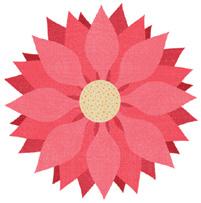

The core of Brown and Gerbarg’s program focuses on three exercises:

1) coherent breathing at a pace of five to six breaths per minute; 2) resistance breathing, characterized by a slight tightening at the back of the throat on the exhale; and 3) moving breathing, an innovative way of using the imagination to circulate energy throughout the body. These exercises, taking about 10 minutes total, have been shown to help balance the autonomic stress-response system, relieve anxiety and other symptoms of stress, and improve sleep. According to Brown, they are particularly effective when combined with an additional 10 minutes of movement and meditation.
Brown and Gerbarg have spent a good deal of time over the past two decades teaching breathing exercises to survivors of mass disasters, including the 9/11 World Trade Center attack, the Gulf of Mexico oil spill,
…
…
… ahhhhhh… breathe in… breatheout … … breathein… breatheout… ahhhhhh…
breathein
breatheout
70 mindful October 2019 well-being
and the Sudan and Rwanda genocides. One of the studies they did after the 2004 Indian Ocean tsunami showed that slow-breathing practices dramatically reduced symptoms of PTSD and depression—in a matter of days, in some cases.

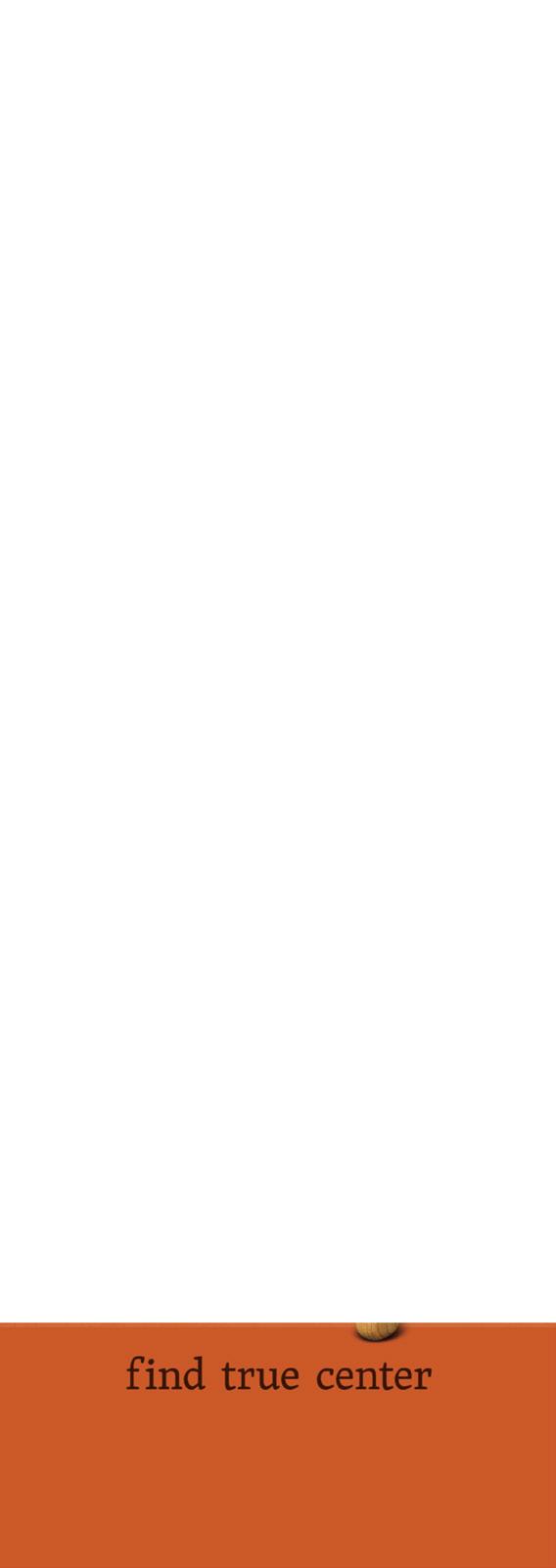
“What trauma does is disrupt the healthy balance of different parts of our nervous system, which are meant to work together,” said Brown. “When people have to strive to survive, their stress response becomes overactive and the soothing part of the system declines. But we’ve found that you can bring it back into balance by shifting the way you breathe. More research needs to be done on this, but our feeling is that breathing breaks the link between negative emotions and the memory of events. It kind of washes away the stored pattern of the incident and reformats your cerebral cortex.”


A moving example is the story of Sonya, an office worker who was miraculously rescued from the World Trade Center. She’d been working in the towers during the previous attack in 1993, so she didn’t hesitate when the first plane crashed into her building on 9/11. She got up from her desk on the 80 th floor and started running down the stairs in high heels as fast as she could. Halfway down the stairwell, she collapsed from exhaustion, but two men carried her the rest of the way, in total darkness except for the faint glow of a distant policeman’s flashlight. Twenty seconds after they escaped, the building collapsed.
Afterward, Sonya developed PTSD and was constantly haunted by anxiety, nightmares, and unbearable feelings of distress. She tried conventional treatment, medication, and some alternative approaches, including resistance breathing. But nothing seemed to work. Finally, seven years later, she signed up for one of Brown’s and Gerbarg’s workshops and made an impressive recovery. At the end of the weekend, she revealed this was the first time since the tragedy that she felt as if she’d gotten her life back. →
October 2019 mindful 71 /simplysittinggear @simply_sitting simplysitting.com f ind t r ue center
the evolution of the meditation bench handcraf ted and cur ved for comfort
Making Friends with the Breath
My experience was somewhat less dramatic. But I spent a few weeks practicing Brown and Gerbarg’s exercises, using the CD included with their book, and was impressed by the calming and energizing effect the techniques had on me. I think it helped that I had done Vranich’s intense workouts and had a greater command of my breathing muscles. At one point, I was so immersed in the long five-breaths-per-minute sequence that I lost the self-consciousness I’d often experienced meditating, and let myself surf along with the breath. The years I’d spent terrified of my breathing suddenly faded into memory.
A few weeks later, I did my last BIQ reading with Dr. Vranich. It seemed almost anticlimactic, given everything we’d been through, but the tale of the tape was indisputable. My inhale measurement was 41½ inches and my exhale 37¾ inches, for a total of 3.75 inches and 99% vital lung capacity.
“Congratulations, sir, you’re a completely horizontal breather!” she exclaimed. Then, without missing a beat, she added, “Now that you’re an A student, why not go for an A-plus?”

You must be joking, I said to myself. But looking into her eyes, I realized that in her view, despite all the work I’d done, I’d just skimmed the surface.


Jim Morningstar, a psychologist I interviewed for this story, describes the breath as one of our most intimate companions because we can’t go for more than a couple of minutes without it. “When you connect with your breath, you’re connecting with your spirit,” he said. “That’s the experience many people have doing breathwork. After a while, they’re not breathing anymore. They’re being breathed.”
Clearly, I still had a long way to go. But I was excited about the next part of the journey because my relationship with my breath had shifted. To borrow Humphrey Bogart’s famous line, it felt as if this could be the beginning of a beautiful friendship. ●
mONLINE MINI-COURSE Calm Your Mind and Focus Your Attention with Zindel Segal
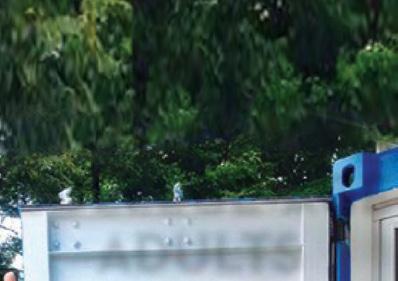




In this 4-part series you’ll explore the 3-Minute Breathing Space practice to develop your ability to ground yourself, return your attention to the present, and fully find yourself at any moment.

mindful.org/ breathingspace
This series is available to subscribers only
72 mindful October 2019 well-being
Bookmark This
SILENCE
A Social History of One of the Least Understood Elements of Our Lives
Jane Brox • Houghton Mifflin Harcourt
An author fascinated by the fundamental aspects of life, Jane Brox has written about family, farmland, and light—all to great acclaim. She is a micro-historian with a farmer’s feel for the value of getting dirt under your fingernails to get to the heart of the matter. Using the modern technique of alternating and intertwining stories, Brox reports on silence as a means of reform in early penitentiaries (thought to be more humane than corporal or capital punishment) and as a means of spiritual development in the monastery.
Silence as means of redemption for criminals is largely a story of the dark side of silence. The prohibition against speaking revealed a deep need to give voice and to commune with others. It was being silenced rather than finding peace within silence: punishment, not reformation.

The dark side is also explored in chapters on the silencing of women’s voices. English law, brought to the early American colonies, meted out punishment to women for “talking too much or too publicly, or in a tone of voice that seemed grating or nagging,” Brox writes, sharing the English legal definition of a scold: “a troublesome angry woman who, by her brawling and wrangling among her neighbors, doth break the public peace and beget, cherish, and increase public discord.”
When Brox turns her historical lens to spiritual silence, we find the key difference between silencing and reveling in silence is community. Monastic orders live together in intimate communion. Only rarely are monastics cut off from others completely, and usually only for defined periods.
Having juxtaposed silence in two very different forms, Brox leaves us to contemplate the interplay between quiet and community, between a silence born of deep listening and one born of wanting others to shut up.
A WALKING LIFE Reclaiming Our Health and Our Freedom—One Step at a Time
Antonia Malchik • Da Capo Press
It’s undeniable that the ability to walk upright has shaped our species. Not just what we can do and where we can go, but what our interactions look like, how we exercise our autonomy, what we need to develop and thrive in every aspect of our being. In A Walking Life, Malchik looks at these factors and more, showing

the significance of walking at various historical moments— and arguing that what it really means to “walk” also includes people with illness or disabilities who have devised countless ways to move through the world. She’ll make you pause over many current lifestyles that, alarmingly, involve precious little time on our feet.
CHANGE YOUR WORLD

The Science of Resilience and the True Path to Success
Michael Ungar • Sutherland House
Social worker, family therapist, and Canada Research Chair in Child, Family, and Community Resilience, Michael Ungar knows whereof he speaks when it comes to how important environment is to health and well-being. How resilient will you be if you’re hungry, poorly educated, and have little access to good employment? And self-help drives him crazy: It makes people think there’s something wrong with
their brain that they must fix. He makes a great point. What’s a little puzzling is why Ungar thinks mindfulness practice has nothing to do with seeing what needs to be changed in “your world.” In his view, mindfulness is an unproven way to trying to fix ourselves instead of our environment, and those of us who love it should give it up. Perhaps, though, if this is the impression we’re leaving, we need to up our game.
October 2019 mindful 73
read…listen…stream
THE INNER WORK OF RACIAL JUSTICE Healing Ourselves and Transforming Our Communities through Mindfulness
 Rhonda V. Magee • Tarcher Perigree
Rhonda V. Magee • Tarcher Perigree
Early in this book, Rhonda Magee tells a little story that both breaks your heart and potently illustrates why she has devoted her life’s work to getting to the heart of bias and helping undo its deleterious effects. She recounts the first time she came to see fully how other people could view her in a completely different light than she and her family viewed her. She saw that there was a wall dividing people—a wall that could be nearly invisible until you bumped up against it.
Magee has brought together experience as a law professor and a longtime practitioner of mindfulness—and training as a mindfulness teacher—to host classroom conversations about race, privilege, and bias that few of us ever take part in, particularly in a mixed-race context. She’s learned a lot from years of this kind of hands-on work. For one thing, it has taught Magee that color blindness is an unhelpful concept for promoting equity and justice. Despite the fact that race is “socially constructed” and ultimately a “fiction,” our perception of significant differences is unmistakable, so we cannot be “blind” to color. That’s simply a prescription for being blind to our biases.
Instead, Magee teaches and practices what she calls ColorInsight, using contemplative practices to peer into and beyond our biases. It starts from a view that we are deeply interconnected, but need to “take a long (lifelong), loving (heartful and compassionate) look at racism,” where “staying in our discomfort” can be “an important part of healing and transformation.” Through instruction, stories, history (both legal and otherwise), and insight, Magee takes us on a very rewarding, vital, and timely journey.
HOW TO DO NOTHING Resisting the Attention Economy
 Jenny Odell • Melville House
Jenny Odell • Melville House
In her debut book, Jenny Odell puts forward an uncommonly rich, poetic ode to the here-and-now, and a call to find belonging in it. While she critiques both “productivityobsessed culture” and addictive tech—Odell grew up in Silicon Valley—her argument surpasses a mere list of reasons to turn off your phone. She looks to (for example) literature, art, working-class and Native American histories, experimental music, and her own experience (as an artist, art educator, and birdwatcher in the Bay Area)
to illustrate the true vibrancy and potency of human attention. Naming attention as our primary resource to combat looming social and ecological catastrophe, she paints a compelling picture of why it’s urgent that we return to a sense of public, embodied space and time. “A simple refusal motivates my argument: refusal to believe that the present time and place, and the people who are here with us, are somehow not enough,” writes Odell. It’s hard not to see the inherent mindfulness of that refusal.
THE POETRY REMEDY Prescriptions for the Heart, Mind, and Soul
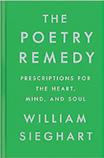
William
Sieghart
• Viking Press
“Leaning in” is a phrase often used by meditation teachers to describe staying with and exploring our discomfort, rather than warding it off with a mental 10-foot pole. In this “poetic dispensary,” Sieghart presents a similarly timetested way to lean in: through poetry. To find that someone far away has already written a poem that expresses the intensity of our own experience, he says, “is to discover a powerful sense of complicity, and that precious realization:
I’m not the only one who feels like this.”
The table of contents is a list of difficulties such as Anxiety, Letting Go, Stagnation, or Rocky Relationships. Under each is a poem that speaks to it, as well as Sieghart’s gentle, perspective-giving commentary. Of course, not everyone who feels X emotion will find comfort in the same words. Still, even if you don’t usually fancy poems, you might lean in to these ones and be surprised by the balm they offer.
ONLINE Q&A with Rhonda Magee
Dive deeper into The Inner Work of Racial Justice
74 mindful October 2019 read, listen, stream
Sign up at mindful.org/ rhonda m
Join
Bring
iBme works internationally to offer in-depth mindfulness programming to guide teens and young adults in developing self-awareness, compassion, and ethical decision-making.








Mindful’s 30-day Meditation Challenge and
For close to two decades, the Mind Body Awareness Project has delivered ground-breaking mindfulness and emotional literacy training to atrisk youth and incarcerated adults to help them transform harmful behavior and live meaningful lives. Mindfulness
to the Next Generation
Sign up today at mindful.org/M30
When you participate in our September Mindful30 Challenge, you will be directly supporting our charitable partners.
PODCAST reviews






TED TALKS DAILY
Episode: “Ella Al-Shamahi: The Fascinating (and Dangerous) Places Scientists Aren’t Exploring”
Delving into our species’ ancient history may let us understand each other more deeply. But what if vital archaeological evidence exists in a no-fly zone? According to Ella Al-Shamahi, an English paleoanthropologist of Arab heritage, science suffers from “a geography problem.” Through the lens of her ordeal in reaching the Yemeni island of Socotra—where she and her team aim to research some of the earliest Homo sapiens to leave present-day Africa—Al-Shamahi talks about the institutional barriers
that often prevent Western researchers from studying in regions deemed politically unstable. Some of these places, nevertheless, offer a great deal to learn about the climate crisis, extinction, and the human journey. Instead of having to completely avoid the unknown, she says, scientists can take measures to greatly mitigate risk when they’re on foreign soil. And by strengthening scientific collaboration across borders, she adds, it becomes more feasible to focus on what we globally share, rather than what seems to divide us.
ON THE MEDIA
Episode: “Uncomfortably Numb”

Journalist and media analyst
Brooke Gladstone talks with experts about a few current events and questions some of the ways we’re seeking to protect ourselves from grief, helplessness, and fear. First up: By constructing an alternate (if totally outthere) version of reality, conspiracy theorists believe they know the world better than the rest of us. Ironically, for them, their “fantasies” lend “a sense of order” to the chaos. Meanwhile, many climate scientists struggle with being on the front lines of comprehending climate change. Even more than
non-scientists, their mental health can suffer from the gravity of what’s happening to the planet. Then, there’s the “Brexit anxiety” that nearly two-thirds of Brits are feeling, and a problem doctors tend to treat as an individual medical issue—never mind that it’s a natural response to the tense political environment. Gladstone ends on the idea that we can counteract numbness by claiming space for ourselves to simply be. It’s in claiming these pockets of freedom that we may discover cracks for the light of change to seep in. (See also How to Do Nothing, reviewed on page 74).
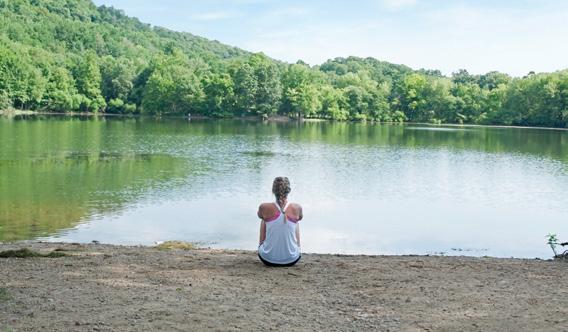
76 mindful October 2019 read, listen, stream
Visit mindful.org/tunein for featured meditations from Susan Kaiser-Greenland, Mark Bertin, and Kristin Neff.
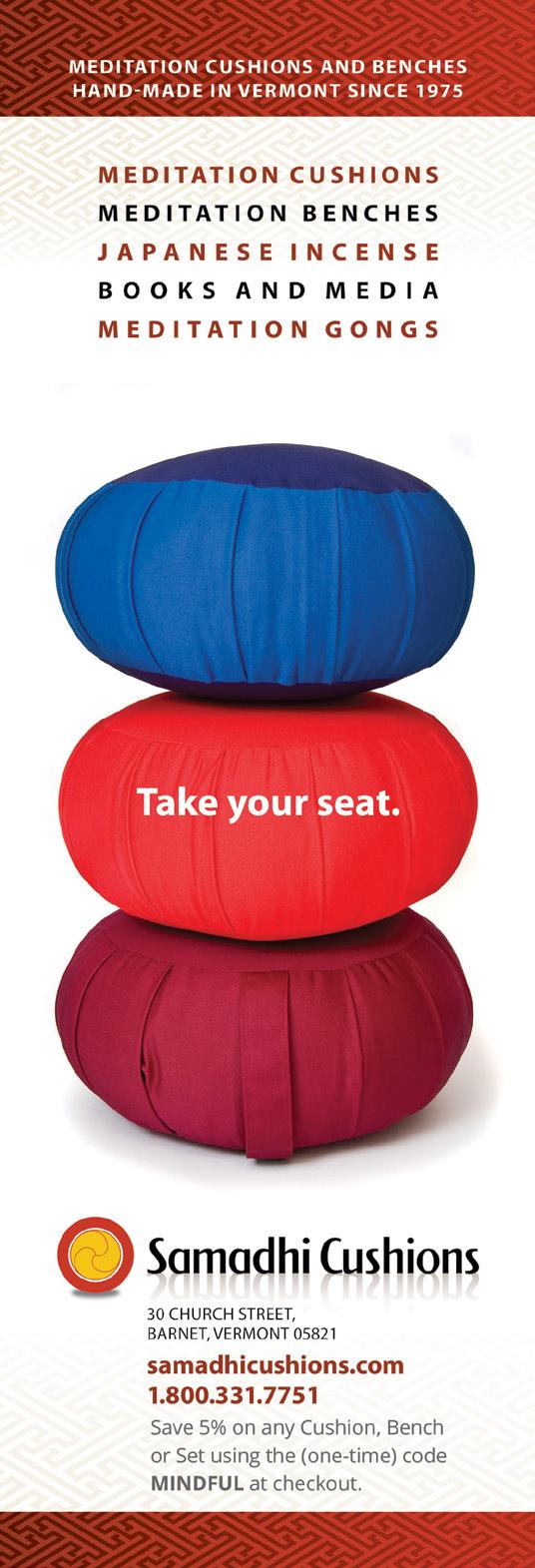
Notice. To simply sit and notice the breath is one of the oldest meditation practices there is. By settling in and staying with your breath for a few moments, you recognize that awareness is always here. You can trust that your breath will find a natural rhythm and that you can simply notice things as they come and go. Take a moment to drop in and notice the stillness that is always with you.
Focus. This simple meditation trains your attention, so you can begin to choose what you’d like to focus on, rather than letting your mind wander aimlessly. Each time you notice your mind has wandered, you have a chance to bring yourself back to the present moment by focusing on the breath. Follow this guided meditation to strengthen your attention with every breath.
Love. Our breath is a nurturing force. Two of the key benefits of loving-kindness meditation are reduced negative emotions, like anxiety and sadness, and increased positive emotions, like happiness and peace. During this meditation, you welcome a loving and generous awareness with every breath you take, directing kind thoughts toward yourself on the inbreath, and kind thoughts toward others on the outbreath. Breathe in, and breathe out. Compassion in, compassion out. There are no limits or boundaries. ●
5-Minute
A 20-minute
3 BREATH MEDITATIONS TO CONNECT
SELF 1 2 3
TUNE IN TO mindful An 11-Minute Awareness of Breath Practice
from Susan Kaiser-Greenland
A
Mindful Breathing Practice to Restore Your Attention from Mark Bertin
Compassionate Breathing Practice from Kristin Neff
TO YOUR BEST
October 2019 mindful 77
mindful marketplace
Welcome to Mindful Marketplace, our catalog of unique products and services for people who want to live with more awareness and authenticity. Marketplace also provides an affordable and elegant way for advertisers to reach and engage our highly committed readers.
To advertise in Mindful’s Marketplace, please contact us today!
Marketplace Advertising
Chelsea Arsenault 902-706-3075
chelsea@mindful.org
Meditate: School of Mindfulness. Leaders in the education of modern mindfulness & meditation
We coach and teach ways to find and share your practice and passion with the world.
Become a Certified Practitioner or Teacher.
Our Immersive Certification programs are designed to provide you with all the tools you need to build your own practice, lead private and group meditations, and teach others, from our school in Fort Lauderdale, Florida.
Certification programs include:
3-Day Sound Meditation Course
3-Day Yoga Nidra Teacher Course
3-Month Mindfulness & Meditation Teacher Course
Please visit our website or contact us for a free consultation.
www.meditateyou.me (954) 641-8315
Three Award-Winning Children’s Books on Mindfulness
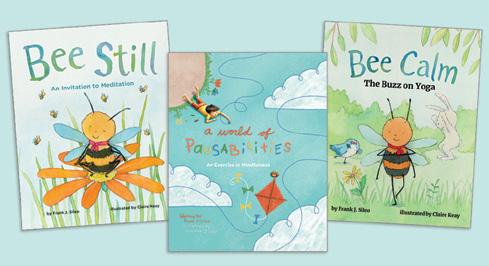
Dr. Sileo’s newest children’s book Bee Calm: The Buzz on Yoga tells the story of Bentley Bee noticing his friends doing some funny poses in the garden. It’s yoga! He learns what that is and does several poses in this kid-friendly introduction to yoga.
Bee Calm is a companion book to Dr. Sileo’s award-winning Bee Still: An Invitation to Meditation. This book teaches children how to use meditation to focus, feel calm, and soothe difficult feelings.
His Award-Winning book, A World of Pausabilities: An Exercise in Mindfulness, teaches children how days are filled with endless opportunities to take a mindful pause, and ways they can apply mindfulness every day.

To order these books: Amazon.com drfranksileo.com
Trauma-Sensitive Mindfulness, Toronto, Canada.
Mindfulness is an incredible intervention for those with chronic pain and stress! Yet the original Mindfulness courses had elements which were likely to take participants outside of their “window of tolerance”, potentially quitting the practice. The MBCPM TM course incorporates both trauma sensitivity, and contemplative art. Join us at our Professional Trainings in the Applied Certificate in MBCPM TM at University of Toronto’s School of Continuing
Studies, Canada. Partial trainings, on-line training options, corporate trainings and mentorship are available. A new on-line Curriculum Training Intensive (CTI) will be starting October 2019.
https://neuronovacentre.com/ mbcpm-facilitator/ team@neuronovacentre.com

marketplace 78 mindful August 2019
Pause… Take a deep breath… Re-Frame your thoughts…
Your Mindfulness Solution - a simple tool to help add gratitude, awareness and meaningful moments to your busy life.
Your meaning to pause® bracelet provides a private, gentle vibration every 60 or 90 minutes, prompting you to pause from whatever you are doing and reframe your thoughts.

Mindfulness Box

A monthly subscription box promoting mindfulness, inner peace and balance by giving you the tools to live with more intention and in the present moment. Each month you will receive 4 - 5 thoughtfully curated items. Use MINDFUL20 for 20% off your first subscription purchase!
www.mindfulnessbox.com contact@mindfulnessbox.com
There are endless ways to decide how you will use your pauses throughout the day.
Available in natural stone, mala beads, sterling silver and more. PAUSE NOW to create a custom bracelet that inspires you and get 20% off your order by using code: PAUSENOW at shop.meaningtopause.com

The Cardinal Mysteries Workbook

Meditation and mindfulness practices often activate energy in the body, increase synchronicity, and awaken extrasensory abilities. This workbook explains the principles of energy and provides exercises to help you navigate the sometimes difficult awakening process.
To purchase: Amazon.com
To learn more about Stephanie Chewning: www.ChewningMindBody.com/ workbook
Cloud Meditation Bench Set
Meditation Bench supports a Cross-Legged Posture:

• More Grounded than Chair
Meditation
• Includes 2" Cloud Bench Cushion and Zabuton Mat
• Easy Assembly, 7 lbs.
Save 5% on any Cushion, Bench or Set using the (one-time) code MINDFUL at checkout.
Samadhi Cushions
1-800-331-7751
www.SamadhiCushions.com
Mindful Leader Programs and Retreats
• Mindfulness, emotional intelligence and positive psychology for work
• Research-based, experiential, CPE-certified
• Deeply experienced, certified mindfulness facilitators

• Practical workplace applications
• Delivered across the US and Europe to 4500+ professionals
Fall Mindfulness Retreat: October 19-20, 2019
www.purposeblue.com info@purposeblue.com

Mangalam Centers, a place to explore mind
We offer mindfulness programs and a residential Mindful Living Program. Our approach to the mind is non-dual, and our volunteers use work to question limits. We offer community events and explore ways to bring full presence to the challenges facing our world.
email: info@mangalamcenter.com
www.Fullpresence.org www.mangalamcenter.com
Age defying on your terms–Naturally
Using advanced antioxidants and transformative botanical blends-Theoderma’s complete line of products yields maximum free radical fighting and skin restoring benefits.

Mindfully crafted to be gentle, effective and cruelty free.
Leaping Bunny / Vegan Certified Use Code MINDFUL for 20% off your first order.
TheodermaSkinCare.com
Info@TheodermaSkinCare.com
marketplace August 2019 mindful 79
SET YOUR EMOTIONS FREE
by BARRY BOYCE , EDITOR-IN-CHIEF

Our emotions are elusive, shape-shifting inner beasts, but despite the challenge of pinning any of them down in precise terms—what is anger, really?—we don’t doubt they’re part of our makeup. We don’t think of an emotionless human being as a good thing.
Yet there is little evidence that emotions were treated with respect throughout much of history. Words that point to emotions in ancient languages are tinged with notions of irrationality or possession by spirits. In the West especially, it seems, emotions were considered irrational. Fortunately, artists came along with an interest in the actual psychological makeup of individuals—the full catastrophe, as it were. During the Renaissance, there was a concerted effort to represent affetti (movements of the soul) in the faces and gestures of the people depicted in works of art. The artists, most prominently Leonardo da Vinci, wanted to portray how people were actually feeling
Whereas these artists were exploring rich movements of the mind and heart from the outside in, mindfulness meditation gives us the opportunity to explore from the inside out. In basic mindfulness practice, we’re instructed to simply notice our thoughts and come back to the anchor of our attention (most often the breath). As we become more accustomed to noticing and coming
back, we become familiar with the quality and texture of our thoughts. Before we’ve decided a thought is bad or good or otherwise, we have a split second to just see it for what it is, as if we were in a creative writing class focusing simply on what we see, not what we think or feel or about it.
When we do that, we definitely notice that some thoughts contain emotional content, and that these emotional “thoughts” arrive as an experience in our body, not just our
Emotions can and do get out of control and, in fact, take charge, and make no mistake about it, when they are out of control they can do tremendous damage! In situations where real harm can result, emotions are not to be treated lightly. In the end, though, it’s much easier for emotions to control us if we fear them, if we feel something is horribly wrong with having them, and if we believe that reason must always prevail and executive function must take control.
This wondrous array of responses is part of what’s beautiful about being human. The longstanding diminishment of emotions as anti-rational has cramped our style.
brain. If you’re angry, you may clench your teeth. If you’re indifferent, your whole body may shrug. If elated, you may shriek. And so on and so on.
This wondrous array of responses is part of what’s beautiful about being human. The longstanding diminishment of emotions as anti-rational has cramped our style. It’s such a shame when we judge emotions as wrong or bad. We’re told that being angry is always a bad thing, that we must calm down and stop being so emotional.
This approach often creates a pushpull with these powerful forces of the soul: We suppress emotions until we can’t take it anymore, then we indulge in them. We keep a lid on our anger till we explode. We pretend we’re absorbed by something that leaves us cold, only to grumble and dissemble in private. Or perhaps we deny our passion, and suffer in silent self-pity or clumsily and fearfully convert our love into possessiveness in an effort to maintain control.
Mindfulness practice, thankfully, gives us a chance to live the whole experience of an emotion—its flavor, its texture, how it lives in our body. And after we have done so over and over again, like a well-practiced fiddle player we can learn to play, not struggle, with emotions. Our strings are tuned, and we play them with precision and abandon.
Will mistakes be made?
Yes.
Can we learn from an emotion gone wild, clean up the mess and the damage, and move on?
We can.
Emotions are a renewable resource. They’re beasts to ride on and revel in, not to lock up because they can become unruly at times. ●
Barry Boyce is Editor-in-Chief of Mindful and Mindful.org and author of The Mindfulness Revolution. He has been an avid mindfulness practitioner for over 40 years.
PODCAST Point of View
m 80 mindful October 2019 ILLUSTRATION BY TOM BACHTELL point of view
Dive in deeper with Barry Boyce and podcast producer Stephanie Domet. mindful.org/pov
Mindfulness might just be the original mobile device.
Like all the most remarkable technologies in history, mindfulness practice draws you closer to the world, by bringing into focus what’s in front of you, and illuminating things you may have otherwise missed.
And like the most portable of technologies, it goes where you go—it’s never further away from you than your breath.

Then again, unlike some technologies, mindfulness practice doesn’t have to make your pockets look lumpy… …it’s entirely self-powered… …it never needs to be upgraded or replaced… …and it won’t stop working if you drop it in the bathtub.

Mind the Moment wants to help you make the most out of all your moments by giving you the best of both worlds— which is why we offer a variety of web-based and in-person training tools, for when you want to feel plugged in, and for when you want to feel unplugged.

The Mind the Moment program was developed and is offered by Harvard Pilgrim Health Care, Inc.
to
@mind_the_moment soundcloud.com/mindthemoment youtube.com/mindthemoment
• www.harvardpilgrim.org/mindfulness
Are you ready
take a closer look at everything mindfulness has to offer? facebook.com/mindthemoment
mindthemoment@harvardpilgrim.org
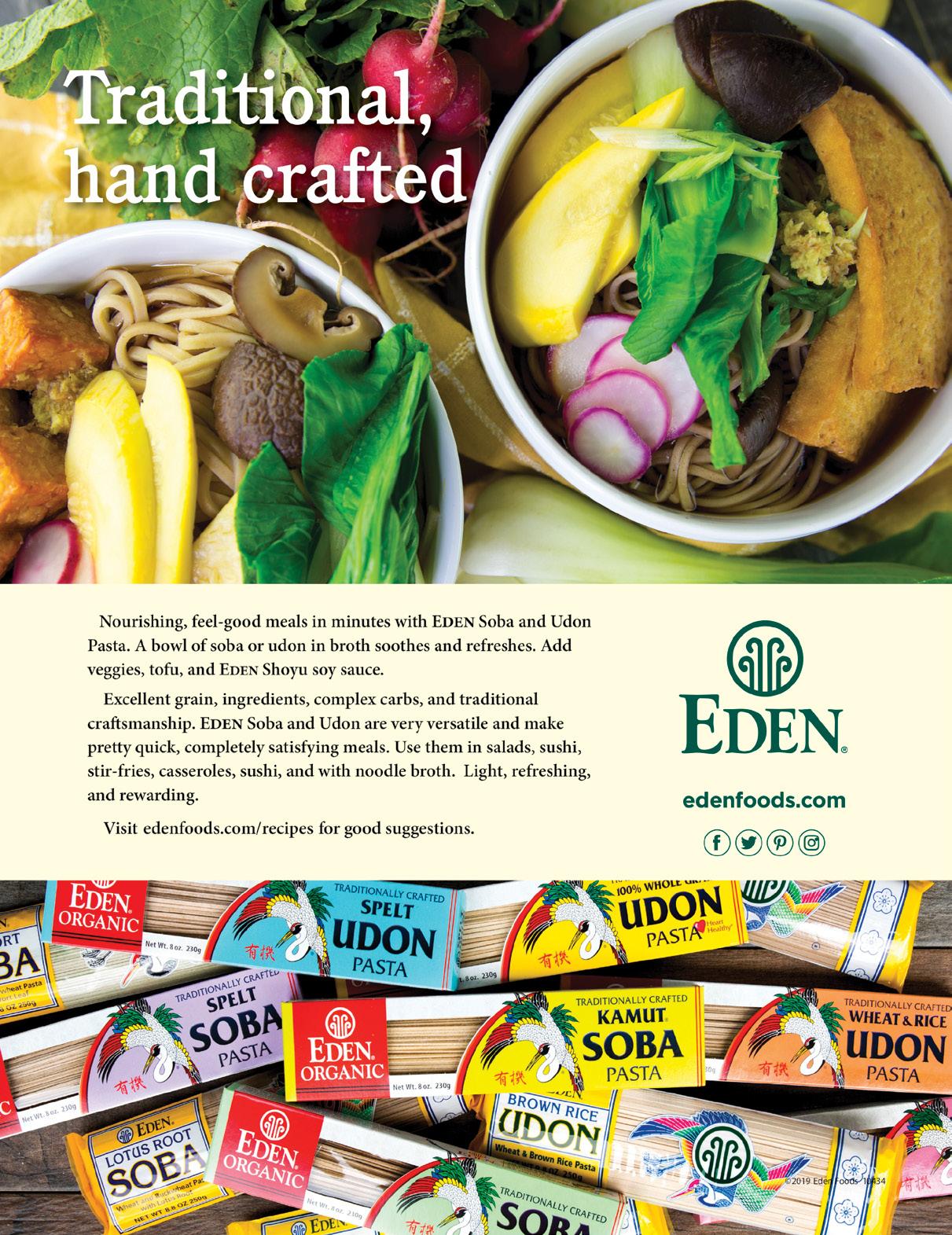

















































































































 PODCAST Unpacking Privilege
PODCAST Unpacking Privilege














 PHOTOGRAPH COURTESY OF JILLIAN PRANSKY
PHOTOGRAPH COURTESY OF JILLIAN PRANSKY




 By Frank Ostaseski
By Frank Ostaseski




 By Hugh Delehanty • Illustrations by Carole Hénaff
By Hugh Delehanty • Illustrations by Carole Hénaff

























 Rhonda V. Magee • Tarcher Perigree
Rhonda V. Magee • Tarcher Perigree
 Jenny Odell • Melville House
Jenny Odell • Melville House




















